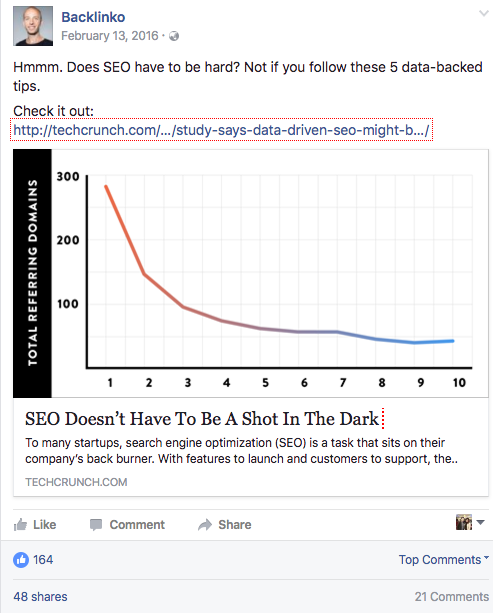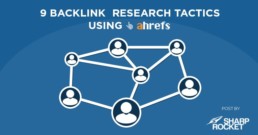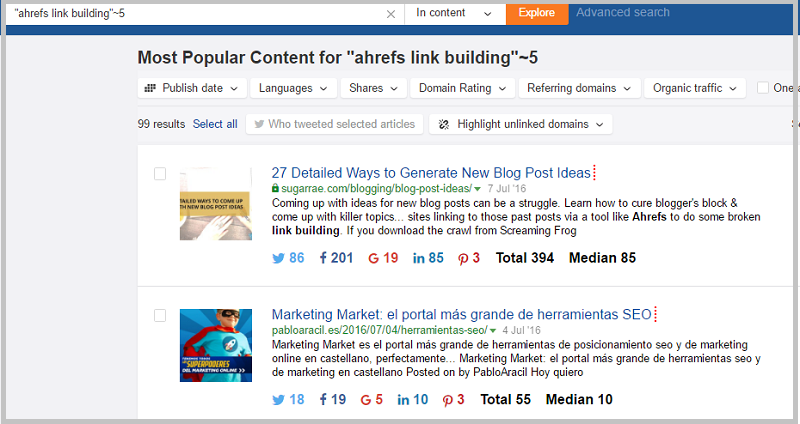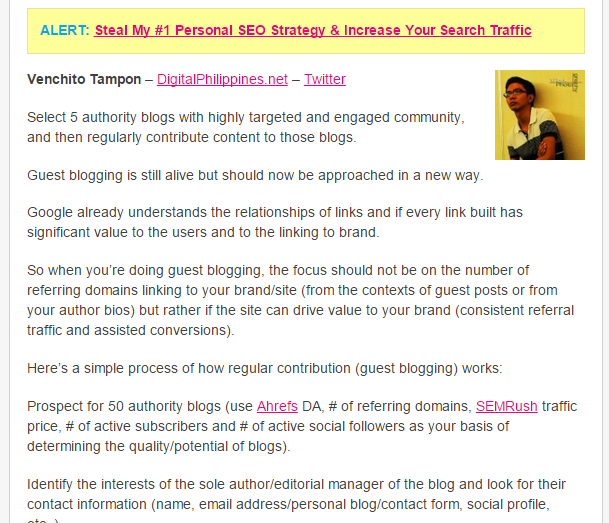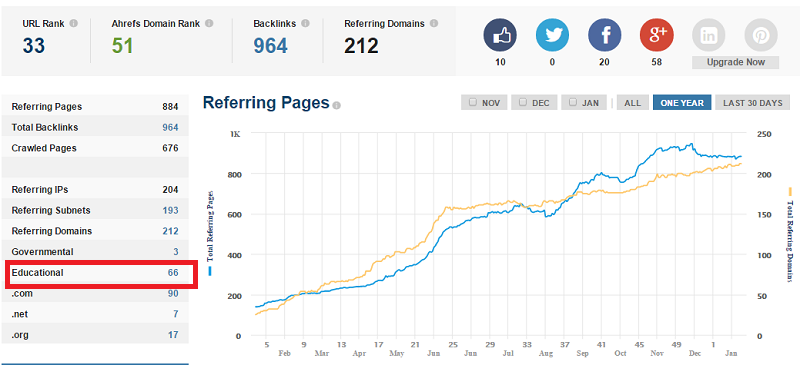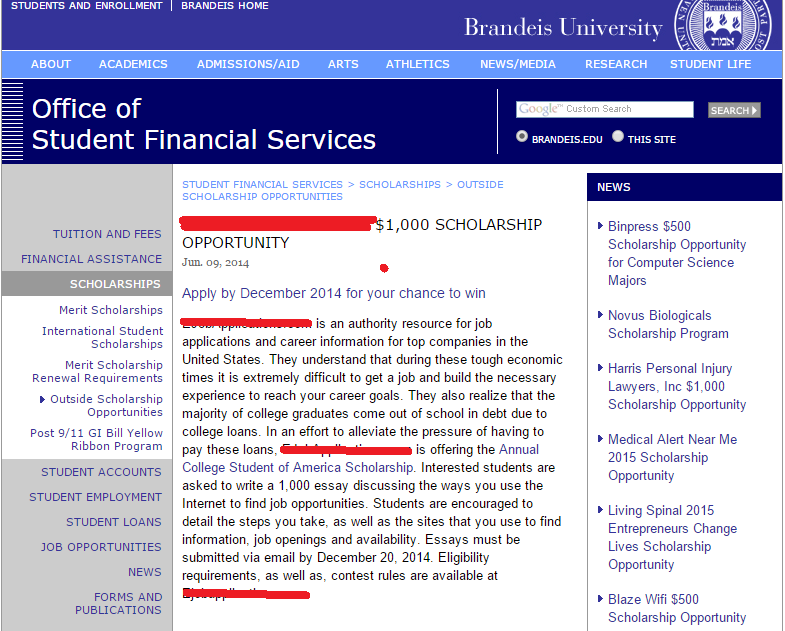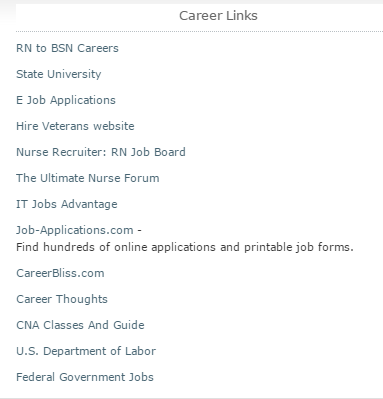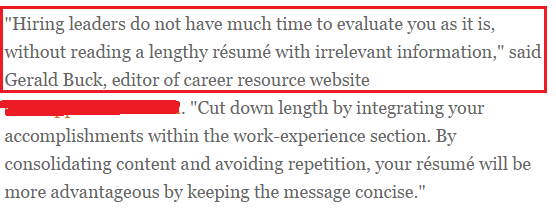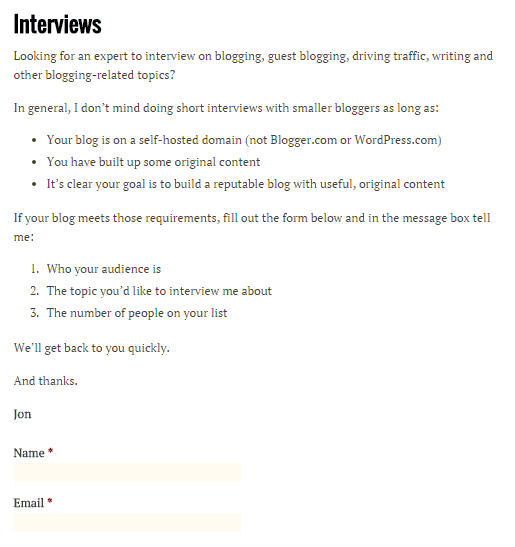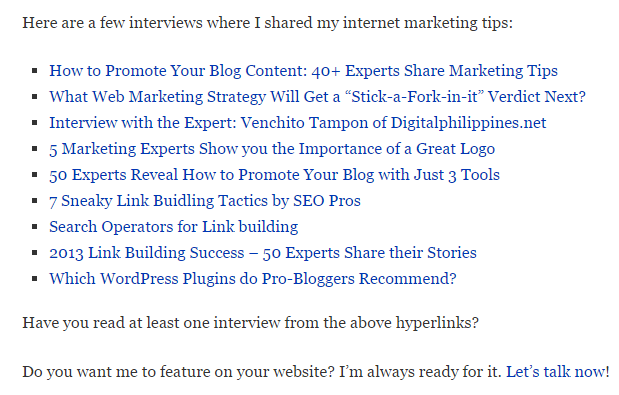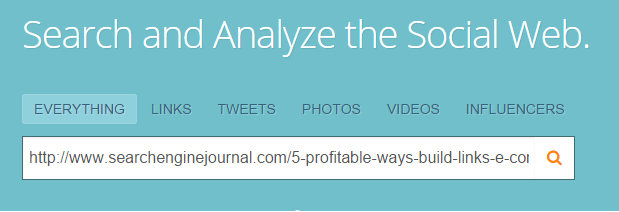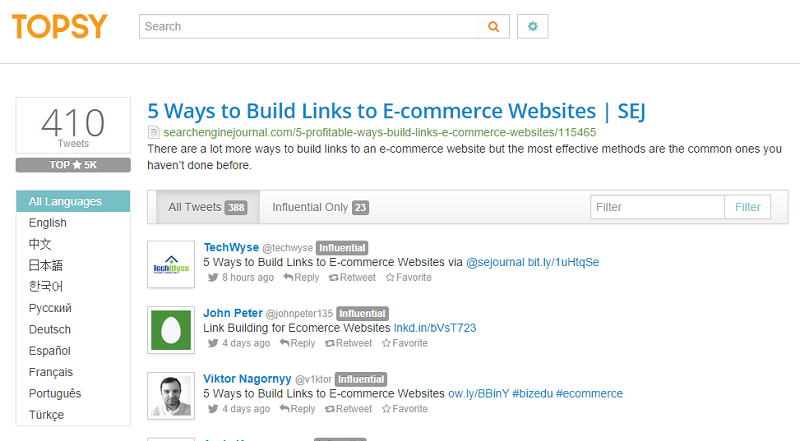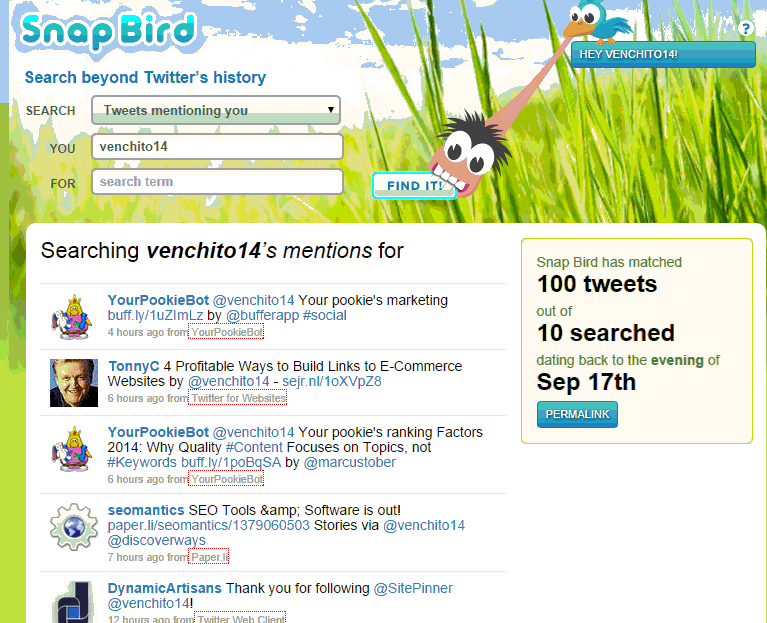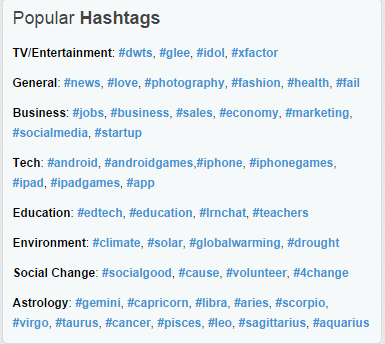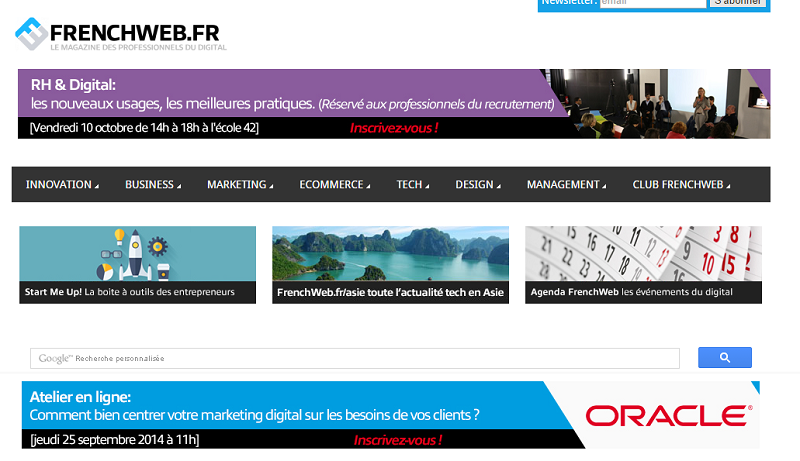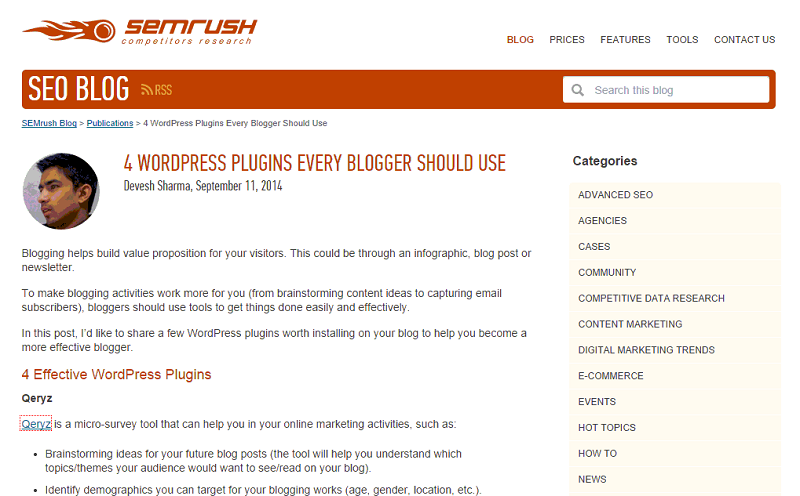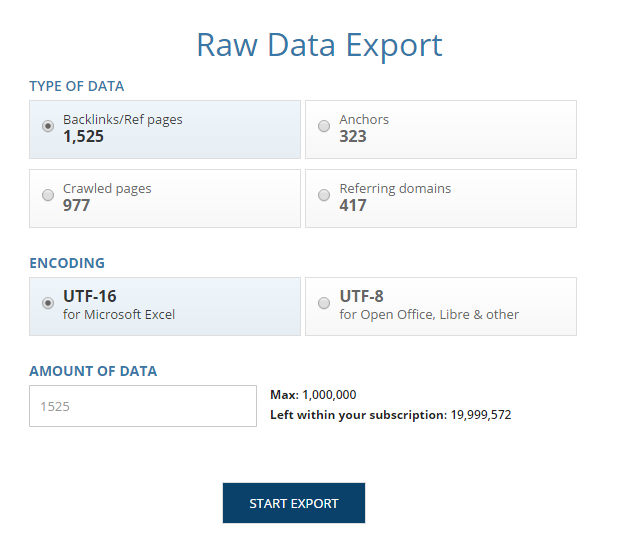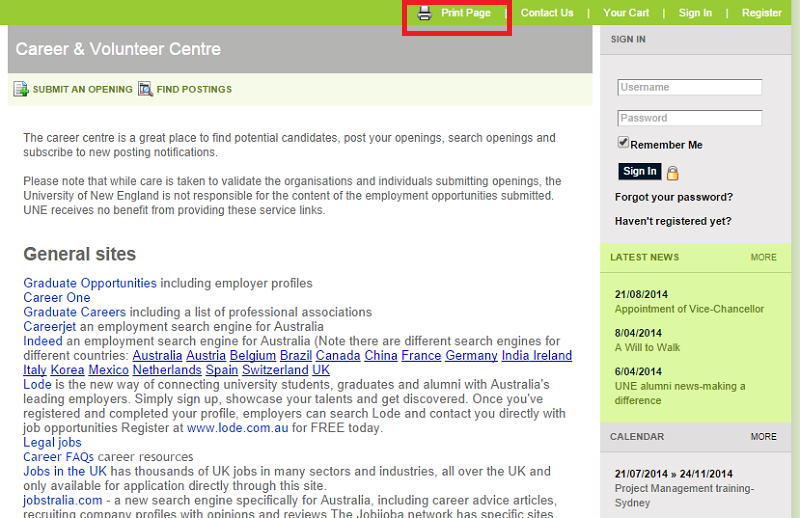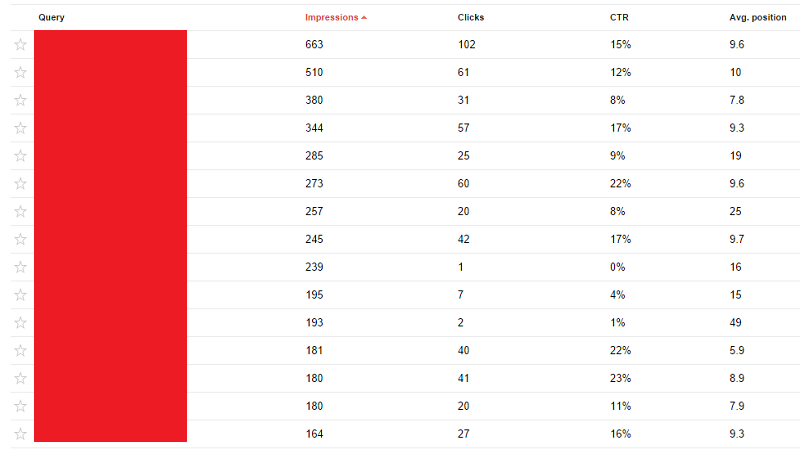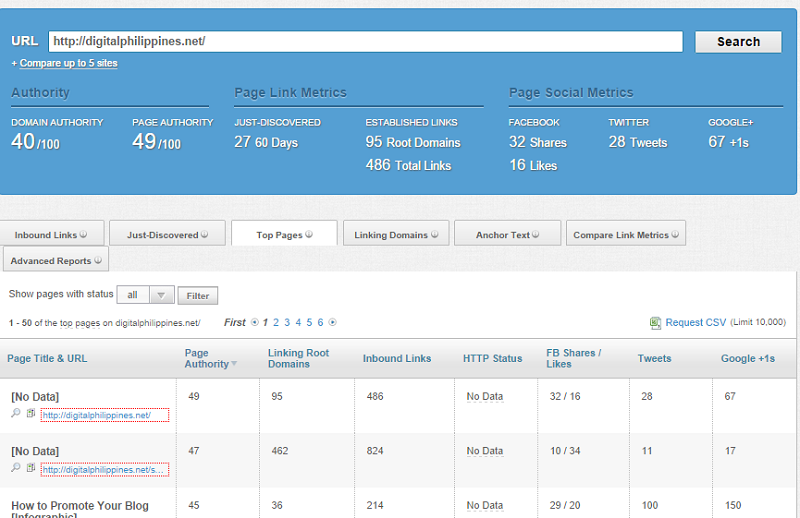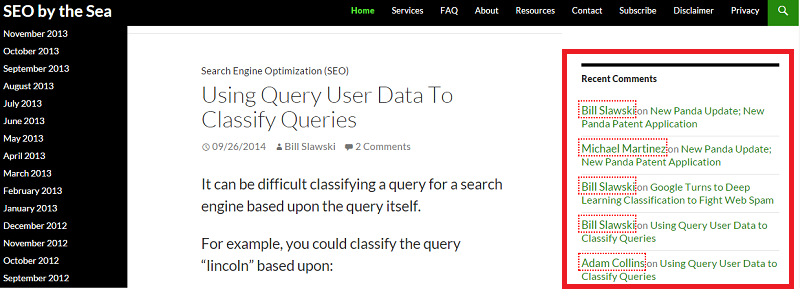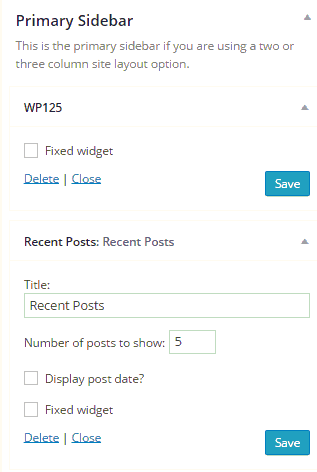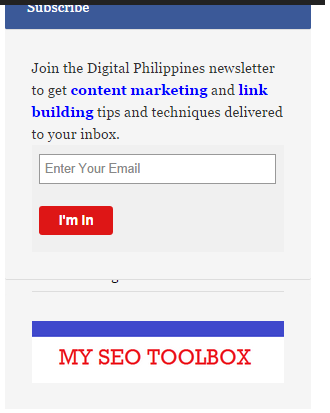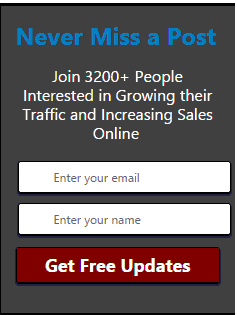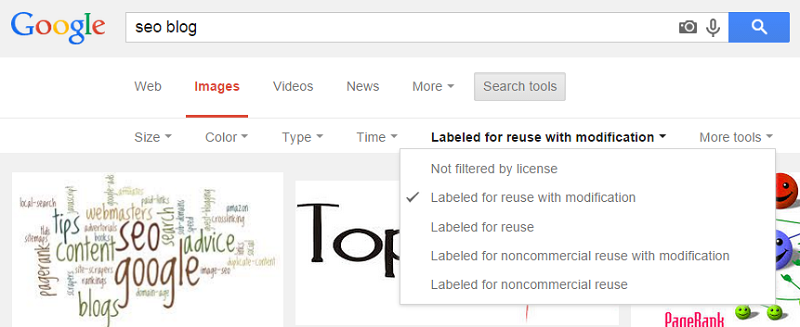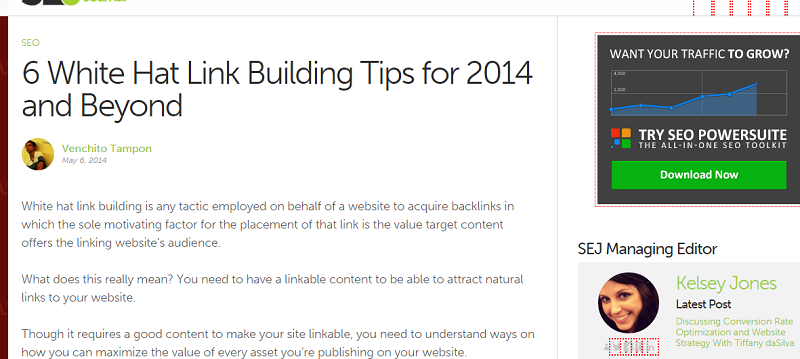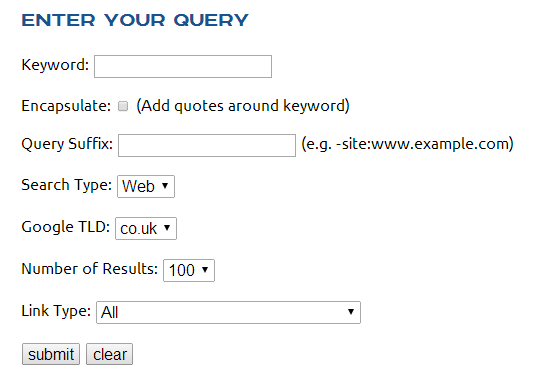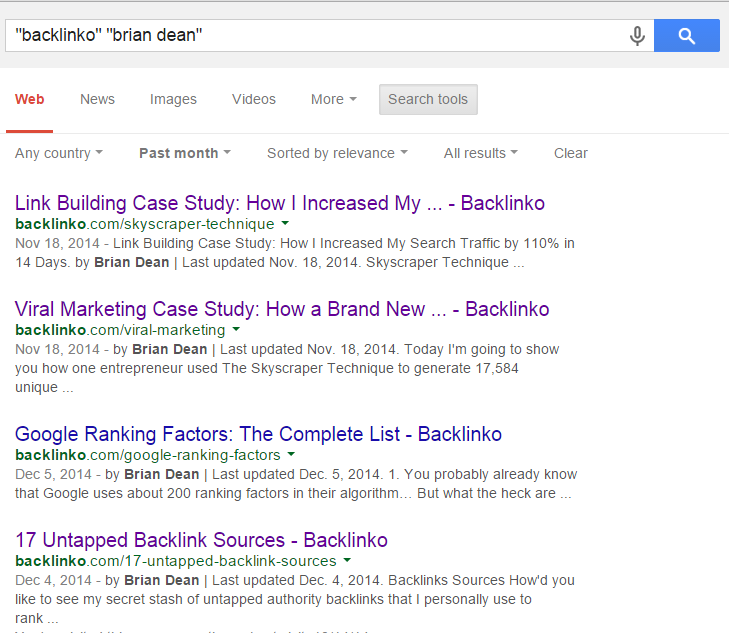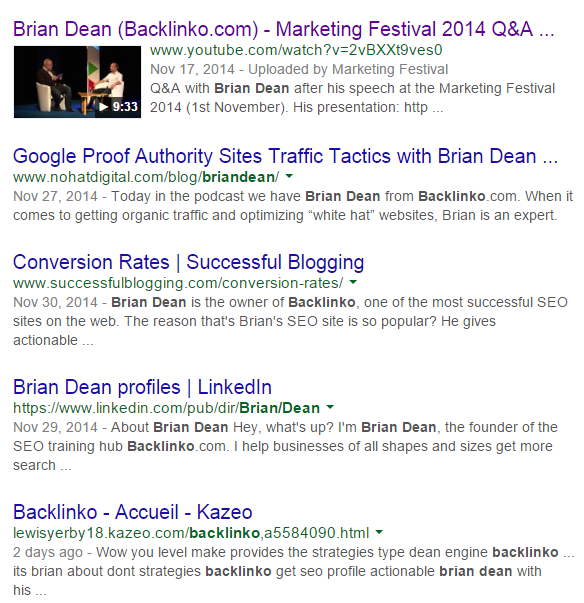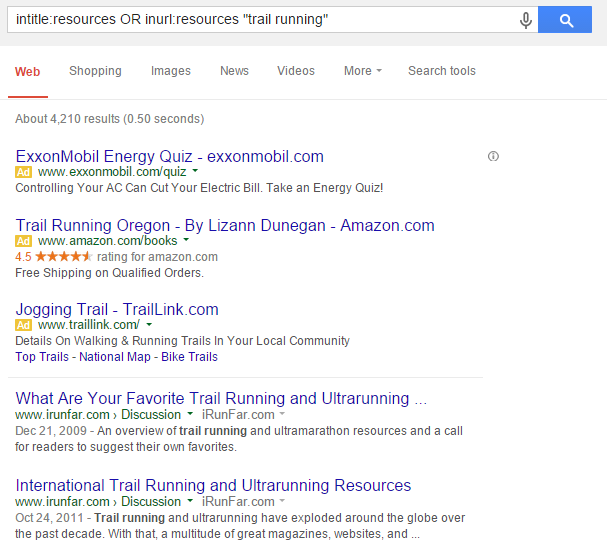4 Reasons Why You Don't Get Resource Links
Every pitch receives a yes or a no. In resource outreach (more often known as broken link building), a "no" isn't a direct response of "no". Instead, a "no" is a reason of so many reasons why a webmaster or the person managing the page couldn't give your desired resource link.
1. NOT CURRENTLY UPDATING THE PAGE

No matter how good the content is, if the page you're pitching to isn't currently open to any link updates, you won't be able to get the link.
So instead of crafting a lengthy email to describe your guide, try sending a short pitch first to ask if they're open for new link suggestions. An email may look something like this:
Just saw your note on your online job hunting page about new suggestions, so thought I’d check and see if you’re still updating the page. If you are, I'm happy to pass along a few new resources for review. If not, can’t say I didn’t ask!
The reason this is important is because you're starting a small conversation first, not taking advantage immediately of the link opportunity with a heavy pitch. You respect the person's time by asking if he or she considers resource suggestions, thus, you come off as less aggressive.
The sooner you get a "Yes" response from this approach, that's the time you can now describe how your content can best fit their links page and their audience.
2. REQUEST OVERLOAD AND SUFFICIENT RESOURCES
With so many SEOs building links to their sites/clients using the same link building strategy (broken link building), it's highly possible that a resource page is getting pitched almost every single day.
Take a look at these emails we've got:
(Request Overload)
 (Sufficient Resources)
(Sufficient Resources)

Obviously there are hundreds, if not thousands, of webmasters receiving similar messages like the one above. It's a reality that you're not the only person pursuing for the same link opportunity. A competition among SEOs/link builders gunning for the same link prize is considered to be a problem, but can also be an opportunity.
If you consider this dilemma problem upfront, you can give yourself an opportunity to ask yourself questions regarding your content before actually pitching them to your link prospects.
One question you can ask is, "Does the content I'm suggesting have competing/similar content pieces on the links page?". What I mean with competing is if you have a "resume templates" guide, does the links page have resume links too? If you cater to both niche audience with the same information, but don't necessarily mean you're competing for the same keywords, that particular content piece is your content competitor.
You may as well check what keywords in URLs those resume links are trying to rank for. If they target the same as your content piece, it may also be considered as your competing content.
Two reasons why you need to check for competing content assets:
A. Know if your content asset fits a subtopic/sub-section of the links page.
This is a good idea because you know that there's a reason for the webmaster to insert a link to your page, as it fits into a category. It's less likely that a webmaster will create another section of the page to just give you the link if in case your content piece doesn't fit to any section.
B. Check if you can fill an informational gap.
To fill an informational gap, you can either create a better version of the content than anyone else (10x content) or provide a unique value (either in format/angle of the topic).
Place yourself in the webmaster's shoes. Ask yourself, why do I need to add the suggested resource on my links page considering there are two or three resource links covering the topic already?.
This question sets the bar of your content's quality - increasing your chances to get
For overload requests, the difference-maker in getting the resource link is your content's comprehensiveness and utility that fills in the gap in the category/information of the resource page.
3. NO CURRENT PERSONNEL TO ADDRESS

It's frustrating to know that the reason you don't get the resource link is not because your content sucks, but there's nobody currently taking care of the resource page.
While there are some high-authority websites with ready-correct department - a group of people who ensures every resource link is reviewed to pass certain standards before they actually go live, there are a lot of other links pages with no current personnel handling them.
We've found that one way to ensure you're not missing those link opportunities is to mark the resource page or create a new tab that includes all of the link opportunities with no current personal addressing them. Then you can set a schedule time to follow up these links after two months.
You've done a lot of work to prospect the opportunity and write an outreach email, so it's a failure to get the potential equity it'd have been developed if you didn't follow up the person.
4. SOON TO DEATH RESOURCE PAGE

It's easy to jump off to another link opportunity when your target links page is going to be killed either because it's of no use to the webmaster or the department/personnel is not updating it anymore.
It happens, but there's a chance they might be creating a new links page with the same topic.
I recommend sending a follow up after a month, asking if they have a new resource page your content might be a good fit is a less work but can gain a return in outreach.
Other Useful Resources
So, those are the four reasons why you don't get resource links and tips on how to pre-solve those problems.
If you liked this post, subscribe to our newsletter and follow me on @venchito14.
Need help with your link building campaigns? Check out our link building services here.
4 Scalable Link Building Tips
For the past few years, the debate about quality versus quantity in link building has been subsiding as more SEOs and business owners have gained a deeper understanding that it's the quality of links that matters over quantity.
Given that, some link builders still find it difficult to consistently acquire relevant links on a monthly basis.
But it's certainly possible with the right approach and improvements in processes to provide solid high-quantitative link reports.
Agencies like Citation Labs, based on their 2015 slide presentation, can accommodate a total of 300 resource backlinks every month to their clients.
Our team at SharpRocket is able to supply links ranging from 6 to 30 in volume to each client on a monthly basis.
It may not be a big number to most readers, but using sweat-and-blood approaches in link building, it's the highest quantity that you can achieve with a handful of resources you have.
Scalable link building requires speeding up phases in the area of link qualification, link prospecting and targeted outreach. Subtle changes that you can make to each phase can tremendously impact your campaign's efficiency.
For the past several months, we've noticed and tested a few approaches that if done well, can create success for your next link building campaign.
1. SOURCING MICRO AND MARCO CONTENT FROM INDUSTRY INFLUENCERS
Content creation for external distribution (or guest blogging) is easy to scale if you've got a team of in-house writers or outsourced freelance writers to accommodate your content writing needs.
However, if you're in scarcity of resources, one approach that you can use to facilitate guest blogging is by interviewing industry influencers and using their Q&A content as external assets for distribution.
Initially we start sending outreach emails to productivity publishers who might be interested to accept any of these two content formats:
- "How-to" [ topic ] interview content
- Guest post on [ topic ] (that includes a few insights from productivity experts)
The key to make this pitch standout is to highlight that you'll be including insights from industry experts in your guest article. Given that publishers would normally ask for high-quality guest posts (as we always request for outside contributors for our blogs), the approach of emphasizing the credibility and value of your content up-front can improve your chances of getting a response and eventually increase your closing rate.
Then you can throw-in topics of content that they can choose from.
 To generate a content idea, you can do a Google search for site:domain.com with any of your targeted keywords or topics (e.g. "personal kanban") and check if these are topics they haven't covered yet.
To generate a content idea, you can do a Google search for site:domain.com with any of your targeted keywords or topics (e.g. "personal kanban") and check if these are topics they haven't covered yet.
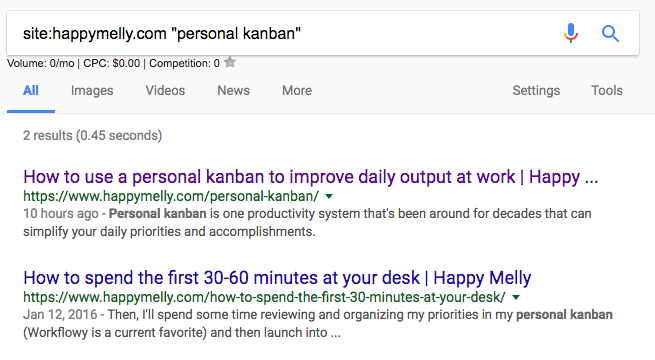 Providing unique content ideas can increase the chances of letting them buy-in on what you can offer.
Providing unique content ideas can increase the chances of letting them buy-in on what you can offer.
Further reading: How to Improve Your Link Outreach Success Rate
When they've chosen a topic to write about, it's time to create the content.
There are two ways on how you can approach content creation: create content with validated insights from influencers or use Q&A content with an influencer and format it as an external asset.
A. Validation To Your Insights
Instead of providing one generic round-up question to your target influencers and compiling them into one big post (just like what you normally read see in most round-up posts), you can ask influencers for insights to questions being discussed in your article draft.
Statements from influencers can serve as a validation to your article points that adds credibility to the overall content.
As an example of this approach, we've looked for productivity bloggers/experts to get their expert opinions on different subjects of productivity.
In my earlier example, the topic that the publisher wanted us to write is "personal kanban" - a personal productivity system.
We had to look for industry bloggers who have personally experienced using such productivity tool in their professional lives.
To speed up the entire blog prospecting process, we chose an authority website that has outside content contributors and that interviews niche influencers on its podcast show (these influencers/contributors were then our target prospects for interviews).

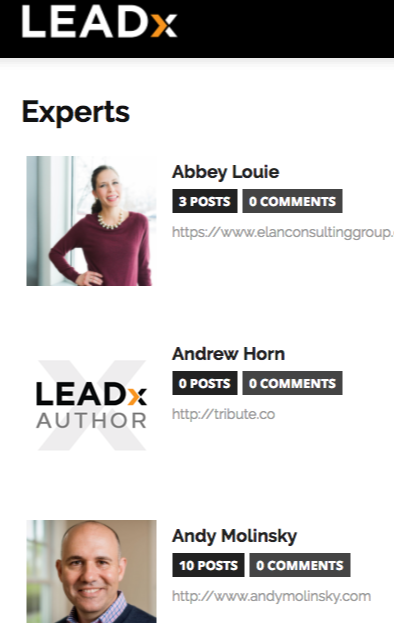
Using URL Profiler to scrape data from author and podcast pages, we've managed to create a list of 20 industry influencers (who are past and current contributors of LEADx.org's blog section and who became guests in their podcast show).
You can also do this process manually, if you're not a subscriber of URL Profiler.
In estimate, the manual approach will only take you 25 to 30 minutes.
Your next step is to gather contact details of your target interviewees to prepare for the outreach campaign.
As for the outreach, it's important to ensure that your authority bloggers will also benefit from the content partnership you're proposing. Reciprocation in a form of getting a link on a guest post written on a top-notch industry blog can increase the chances of getting positive responses from them.
Here's the exact email template we used for this kind of outreach:
Short interview with you [Name]
Hi [Name],
I'm [Your Name], a blogger and productivity enthusiast. I've found you on one of the podcast episodes of Kevin Kruse at LEADx.org and learned great insights from your conversation with Kevin.
I'm fascinated and wanted to conduct a short interview with you. I'll ask a few questions, compile your answers and use it as a guest content for a top-notch productivity site (not mine).
I greatly appreciate your response in advance.
Thanks,
- [Your Name]
From 20 authority bloggers we pitched for interviews, we managed to get 14 positive responses.
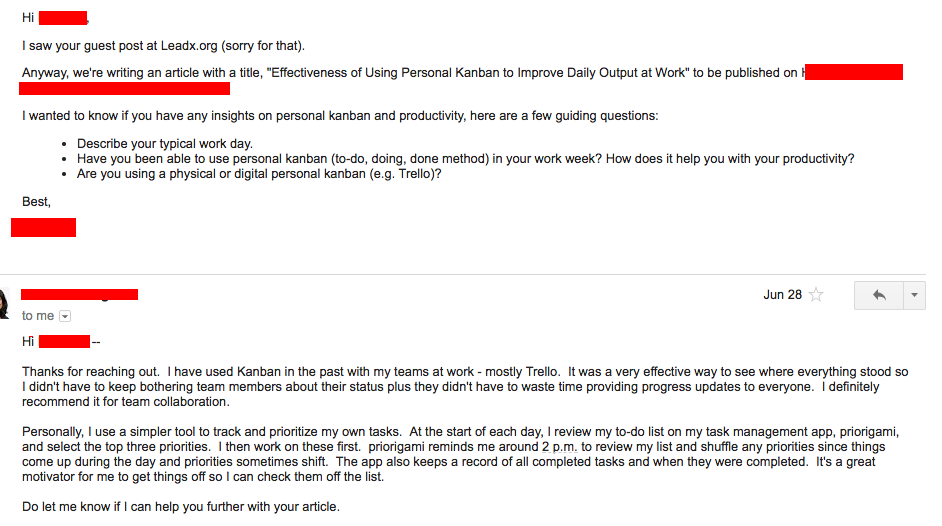
Here are some takeaways why the outreach campaign worked:
- Used prospects' name and their websites' name.
- Included the source where we've found them (I've found you one on of the podcast episodes …) - helps strikes a more personal approach on the email.
- Stated the value proposition to easily catch the interest of the outreach prospect (use it as a guest content for a top-notch productivity site). It helps secure confidence that their answers to questions can reach more audience.
- Straightforward subject line to get the message across.
You may want to check out this guide on blogger outreach to get more tips on how to effectively craft email copies specifically for blogger outreach campaigns.
Finally, you have to submit your finished content with great insights from niche influencers for content approval.
Then, acquire links:
A link to the influencer's website (for his contribution):
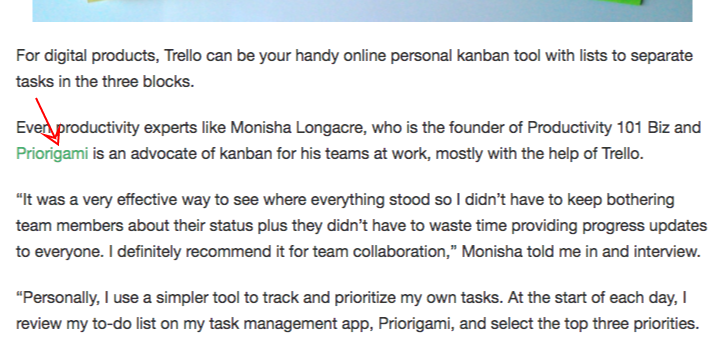 A link to our website:
A link to our website:
B. How-to Interview Content
There is another way to maximize interview content besides using it as a validation to your article points - that is, utilizing the entire Q&A content as your guest post.
It is best to format it as a "how-to" article rather than just compiling expert's answers into a Q&A format and submit it directly to your target publisher.
You also have to structure the content in a way that is easy to scan and read, and that emphasizes the "specific topic" you're discussing about.
So the title can be something like, "How to [Topic] with [Influencer's Name]".
2. SCALE BLB PROSPECTING WITH CITATION LABS
For the past several months, I've been using Citation Labs heavily to scale prospecting for resources pages (or links pages) for our broken link building projects.
Disclaimer: I'm not an affiliate marketer of this tool.
Given that broken link building requires tedious work on prospecting especially if you're working on several BLB campaigns, using a tool to prospect thousands of relevant link opportunities is definitely a big help.
Using Citation Labs for a broken link building campaign, we've managed to create a list of 22,000+ job and career-specific link prospects with Domain Authority of 40 and above.
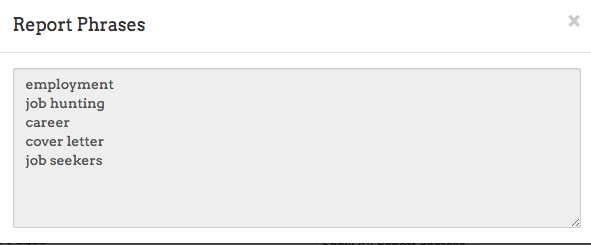
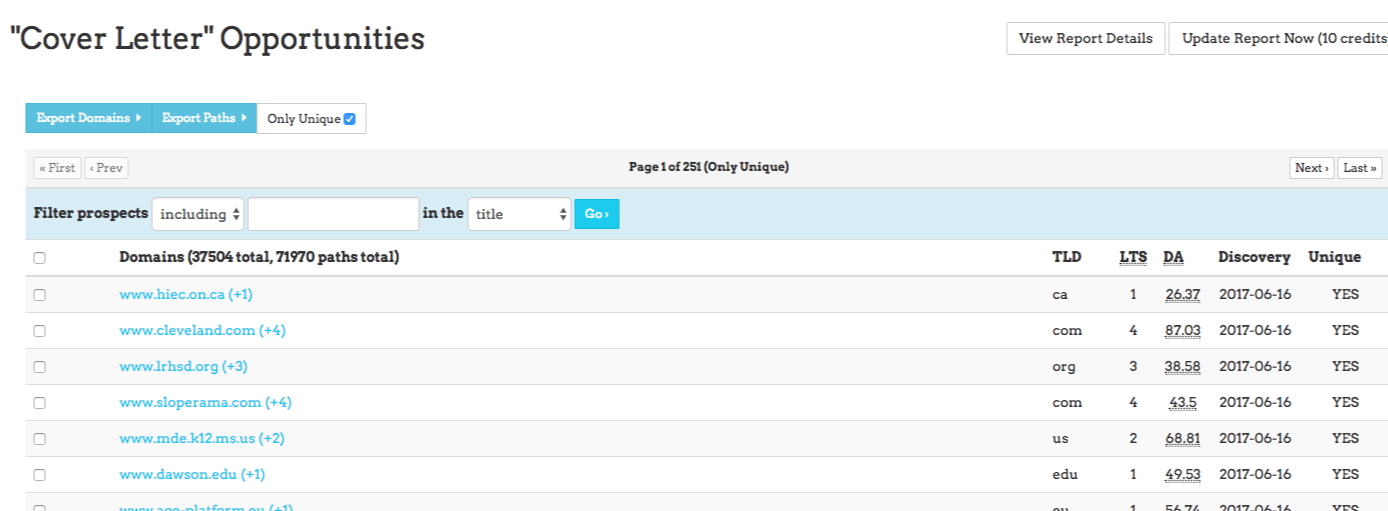
The list is further qualified to pass the relevance test, which resulted to 400 targeted prospects out of the first 10,000+ unqualified pages (4% qualification rate).
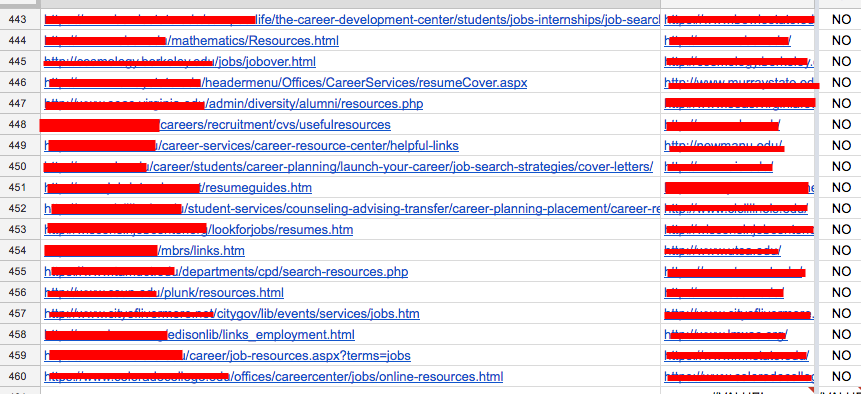
On average, we can qualify 1000 prospects based on relevance within 15 to 25 minutes. So the total time it took us to conduct relevance test for 10,000 pages was 2 1/2 hours to 5 hours.
Assuming you have a newbie link builder and he manually searches for link opportunities, it'd probably take him 3 to 4 hours to find 30 to 40 links pages qualified based on relevance and certain metrics like Domain Authority.
So for 400 qualified prospects, he would consume 40 hours equivalent to 1 week of work.
Notable advantages of utilizing Citation Labs for bulk link prospecting are:
- Improved efficiency in prospecting - as it requires less hours to manually prospect for link opportunities, so time can be spent on qualifying link targets based on relevance and obtainability.
- Expand link lists for untapped link opportunities - pages discovered by the tool aren't necessarily ranking for linker-based queries (inurl:resources "topic").
Besides searching for links pages, Citation Labs can also help link builders to find other type of link opportunities such as review pages, forums and professional organization sites.
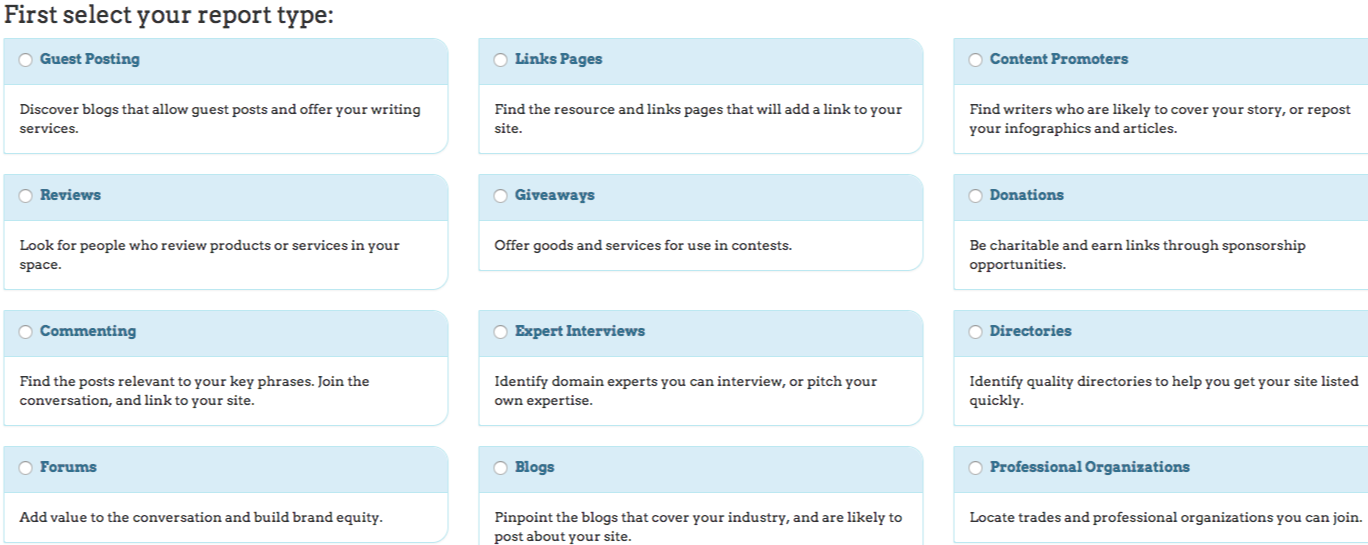
3. HIRE VIRTUAL ASSISTANTS FOR MENIAL TASKS
Apparently, outsourcing is a cost-effective strategy that can improve your link building campaign's efficiency. By giving menial tasks to freelancers, it helps you allocate more time on other important activities, which can help elevate individual and team's output and productivity.
Basically, the tasks that you'll be outsourcing are ones that'll only require basic knowledge and skills and can somehow be executed right away even without much deeper training.
Here are a few examples of link building tasks you can outsource to:
- Contact finding (name, email address, contact forms and social profiles - if email address is not available).
- Finding important page or site-level details (page tilte, article title)
- Initial pitching (sending your outreach emails using an email template with only a few tags to replace details with)
As an example, we recently started hiring virtual assistants locally (freelancers who are based here in the Philippines) and from other countries like Bulgaria to help us with bulk link building activities.
Instead of posting online jobs to facilitate hiring, we use Linkedin as a platform to manually search for freelancers who had previously worked for a similar company (either a full SEO service agency or a link building company).
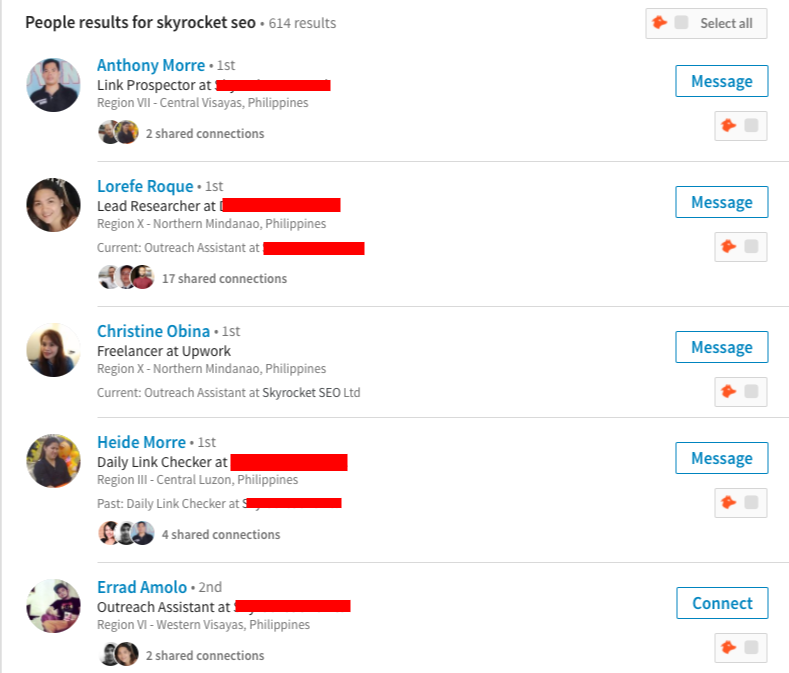
The advantage of doing so is we were able to hire freelancers who can deliver more output than someone who just undergo a training process.
We also checked their work histories if they handled previous link building campaigns or any associated tasks like contact finding and daily checking of emails.
Before jumping straight to outsourcing, we created simple step-by-step documents that walks them through the entire process of executing the task to avoid recurring questions we'll then received from them, as they work on each campaign.
We use GDocs to easily share documents to our freelancers.
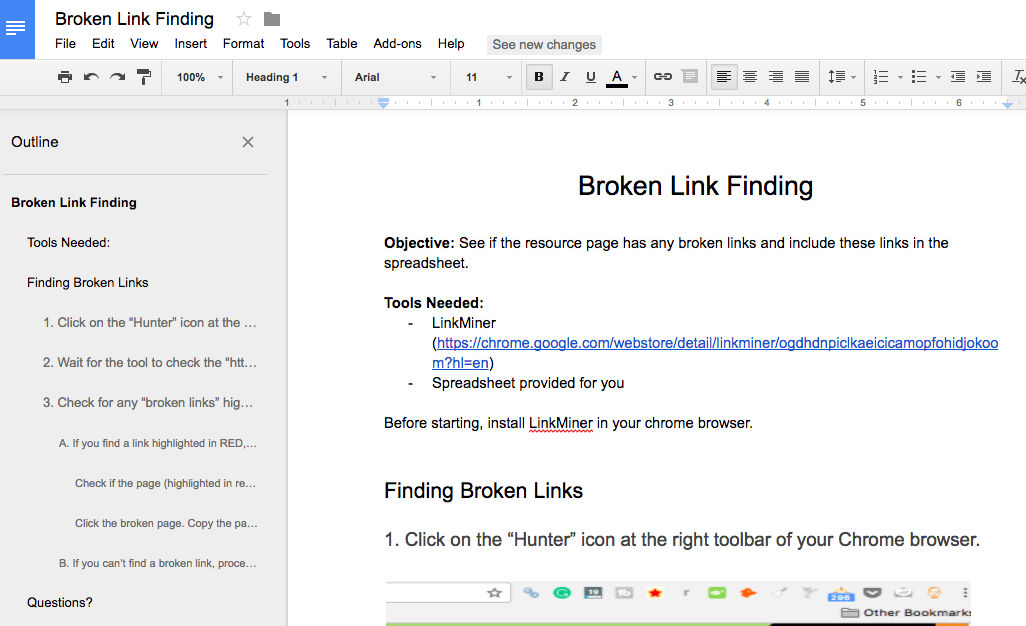
This outsourcing approach can certainly improve your campaign's efficiency with the right people and processes.
Further reading on outsourcing:
4. PERSONALIZED EMAIL MERGE
As quoted by Jason Acidre on his SEO blog, "Outreach is probably the most tedious component of our marketing discipline because the activity primarily intends to build relationships."
I couldn't agree more with this statement, as we've done hundreds of outreach campaigns and to only succeed is to put the hardest work in creating the best offer (value prop in emails), in prospecting for highly targeted publishers and in sending email copies that'll mutually benefit both parties.
There's one subtle approach we've tested to improve the efficiency of our outreach campaigns - that is using a personalized email merge tool.
We initially start by installing Yet Another Email Merge to Google Spreadsheet as an add-on tool. It allows us to send 50 emails in every outreach account for free (there's a premium price if you're sending 400 emails a day).
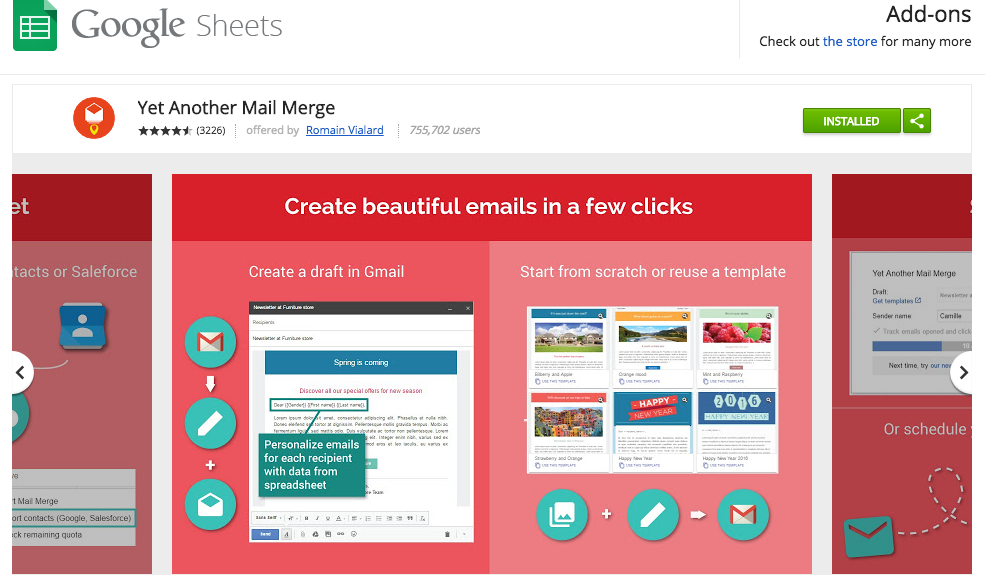
Unlike the typical mail merge system that blast off email spams to publishers, this email merge tool allows us to personalize email copies while semi-automating sending off emails and scheduling them at the right time when prospects will likely to open.
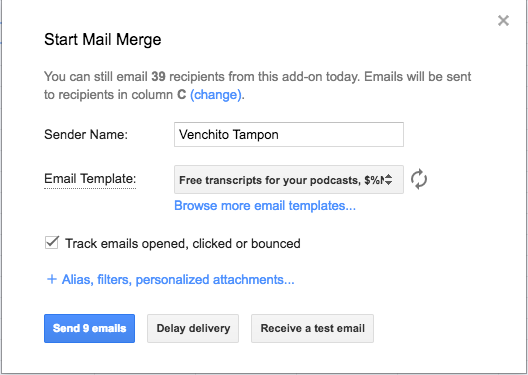
Note: When using this approach, it's extremely important to set intervals in outreach, not to trigger Gmail from spamming your account. Instead of sending 400 emails one-time off, you can divide them into 5 or 7 days with intervals if possible, and just send 40 emails a day.
Here are a few advantages that this tool can bring to your outreach campaign:
- Enables scheduling features for different timezones.
- Tracks open and response rates as well as how many emails were sent and bounced back (or had errors in sending).
- Failed messages (bounced back emails or emails with technical errors) can be replaced immediately with secondary emails which streamlines your follow-up or second-pitch processes.
- One-click away from Google spreadsheet to schedule emails.
![]()
The said outreach tool requires a draft email which serves as your outreach copy to send or schedule emails. Using tags ($/Name/$) in your draft email is important to extract data from your spreadsheet and produce personalize emails.
This outreach approach can benefit you in so many ways, such as:
Initial-pitching using successful outreach copies
If you've tested a couple of outreach templates and one of them has successfully earned the highest open, response and closing rates (or even just the highest closing rate), you can use your most effective outreach template as your email copy in Yet Another Email Merge function for your next outreach campaign.
Follow-Ups
It would be more efficient to send short and straightforward follow-up emails using Yet Another Email Merge tool, which only takes 10 to 20 minutes to complete, than manually sending/scheduling all follow-up emails using your outreach accounts.
![]()
Considerations When Using Yet Another Email Merge
As you get your hands on to this tool, you may experience a few mishaps that can be avoided if you've taken a note of them.
Semantic Breaks
Ross Hudgens discussed semantic breaks in his outreach best practices post that should be noted carefully if you want to secure positive responses in your outreach campaigns.
A good example of this is when you send an email to a person with a tag, "I saw your post on venchitotampon.com blog" and you're addressing it to the blogger himself, "Venchito Tampon". A normal person would rather say, "on your personal blog" instead of naming the whole domain.
When you start using the tool, you might create a column for Website/Blog Titles that includes all branded names of your target link sources.
If not carefully checked, you might put the whole domain (venchitotampon.com) instead of inserting "personal blog" or "personal website".
Leaving off blanks
The tool requires you to create columns for Names, Email Address and other tags such as, Blog Name and Asset Title to further personalize your email copies.
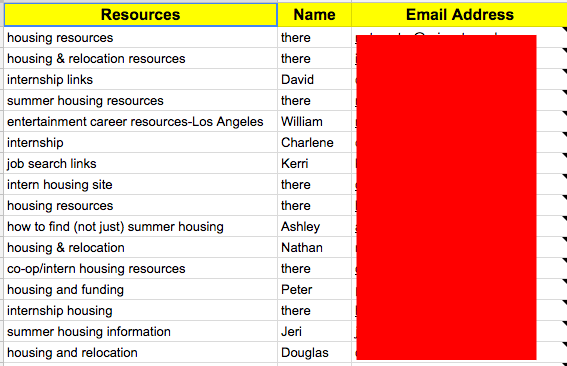
All columns should be filled out with necessary input. Otherwise, you might see an email sent that sounds like a spammy build blast.
My trick here is to input the word "there" to blank cells in the "Names" column for email addresses with no available and visible names.
The final email copy will look like this:

If you liked this post, subscribe to our newsletter and follow me on @venchito14.
How to FuturePoof Your Links By Determining Lifetime Link Value
As defined by Wikipedia, life-time value (LTV) is a prediction of the net profit attributed to the entire future relationship with a customer.
This business concept enables entrepreneurs and marketers assess payback of advertising spent in promoting a product/service.
Replicating this same principle to link building campaigns can enable us to future proof links by considering their long-term effect on the pages they’ve linked to.
What is lifetime link value?
Lifetime link value is a self-evaluated prediction of the entire value of a backlink target to assess its potential impact to its destination pages. (coined by Ross Hudgens).
The great thing about using lifetime link value is that it can serve as a basis in determining the worthiness of getting a link from a page/site through its potential referred traffic, branding and assisted conversions, and by considering the resources you’ve put into place to acquire the same link (cost for content, time for prospecting/outreach, etc..).
There’s no absolute metric to measure individual lifetime link value of backlinks. However, knowing what makes one link more valuable than the other (because not all links are equal) can help you set standards in qualifying link targets and in prioritizing outreach based on which sets of link prospects can potentially bring long-term results for your campaign.
Link Value Factors
Search engines use a wide range of factors to determine how much weight each link on a page may pass along.
The Reasonable Surfer model, which was discussed by Bill Slawski in his 2010 post covered these three determinant sets of link value:
-
- features associated with links
- the pages these links had been placed
- pages being linked to
In detail, examples of each link determinant set are stated below.
Examples of features associated with a link might include:
1. Font size of anchor text associated with the link;
2. The position of the link (measured, for example, in a HTML list, in running text, above or below the first screenful viewed on an 800 X 600 browser display, side (top, bottom, left, right) of document, in a footer, in a sidebar, etc.);
3. If the link is in a list, the position of the link in the list;
4. Font color and/or other attributes of the link (e.g., italics, gray, same color as background, etc.);
5. Number of words in anchor text of a link;
6. Actual words in the anchor text of a link;
7. How commercial the anchor text associated with a link might be;
8. Type of link (e.g., text link, image link);
9. If the link is an image link, what the aspect ratio of the image might be;
10. The context of a few words before and/or after the link;
11. A topical cluster with which the anchor text of the link is associated;
12. Whether the link leads somewhere on the same host or domain;
13. If the link leads to somewhere on the same domain,
• Whether the link URL is shorter than the referring URL; and/or
• Whether the link URL embeds another URL (e.g., for server-side redirection)
Examples of features associated with a source document (the page being linked to) might include:
1. The URL of the source document (or a portion of the URL of the source document);
2. A web site associated with the source document;
3. A number of links in the source document;
4. The presence of other words in the source document;
5. The presence of other words in a heading of the source document;
6. A topical cluster with which the source document is associated; and/or
7. A degree to which a topical cluster associated with the source document matches a topical cluster associated with anchor text of a link.
Examples of features associated with a target document might include:
1. The URL of the target document (or a portion of the URL of the target document);
2. A web site associated with the target document;
3. Whether the URL of the target document is on the same host as the URL of the source document;
4. Whether the URL of the target document is associated with the same domain as the URL of the source document;
5. Words in the URL of the target document; and/or
6. The length of the URL of the target document.
In the continuation patent (deeply discussed by Bill Slawski in his 2016 post), user behaviour on the page seems to be emphasized more as an important factor of link valuation. A link with high probability of being clicked on a page carries more weight than other links on the same page with no actions by users.
Further Reading:
- 20 Attributes that Influence a Link's Value
- 17 Ways Search Engine Judge the Value of a Link
- Link Value Factors by Wiep
Visible Determinants of Lifetime Link Value
Evaluating links on a naked-eye standpoint is feasible given that there are visible clues that can be found on potential linking pages.
While some determinants provided below may require first-hand analysis on websites’ backlink profiles, it will only take less than 2 minutes of your time to generally evaluate a website/page for a link opportunity.
1. Topical Relevance
Relevance, no doubt, should be the primary factor when evaluating the value of a link target. In fact, the majority of top link builders/SEOs in this latest round-up post prefers a highly-relevant link but low authoritative link than a high-authority link with lower relevance, considering all other metrics being equal.
I’m fortunate enough to participate in the group discussion by sharing my insights on the topic:
“I strongly believe that relevant links have a bigger impact on the algorithm. More so, authority is pretty subjective, as metrics available on SEO tools out there can be flawed; how users/website visitors look at sites is mostly based on the relevance and utility of the information they’ve found on a given page.
“Also, in terms of scalability, you’re likely to get a bigger list of highly relevant link prospects, sitting in a very specific niche, than finding only high-authority sites with your choice of metric. Plus, if you’ve been reaching out to a webmaster, it makes more sense for them to give you a link if they think you’re highly relevant to their sites.”
Lifetime link value goes up when a certain page is highly relevant to your website. Meanwhile, if it’s a link off-topic to the destination page, its LLV certainly goes down.
One approach that you can use to determine the thematic relevance of a page is by using Majestic Backlink Analyzer.
The tool allows you to get an overview of the topical trust flow of a site.

Use this approach only for certain sites that you’re unsure of with relevance requirements.
Another tactical approach you can use for topical relevance is by checking the site’s list of categories. For generic blogs like travel, some of which have second-level deep categories like medications/insurance, you might find good link opportunities to acquire links from on a page-to-page relevance basis.

However, for niches with large linkable market audience, it isn’t a good idea to obtain a link from a domain with no category fit.
2. Evergreen Linking Source
The timeliness of a topic can either recede or raise a backlink’s lifetime link value.
An evergreen content idea like “how to tie your shoes” for example is less likely to become extinct than a marketing technique in SnapChat (who knows there’ll be another set of social media sites and new tactics to effectively use them?).
While trends can be taken advantage of for new linking opportunities, acquiring a link from an evergreen page can result to better ROI. It can help continuously drive traffic to your content as long as people can find the information on the linking page relevant and useful.
Given that the source page can improve its visibility by itself, getting in-content links directly to your content from publishers who are looking for references for their works (in addition to to the evergreen content they’ve seen) is also highly possible.
3. Link velocity
Domains that market themselves are great opportunities to build links from, as they continuously bring new visitors from organic channel (when they happened to rank for several industry keywords) which will then drive secondary traffic to your content.
Link velocity can be a visible determinant of the page’s marketability.
Link velocity describe the speed of link growth to a page or domain. Link velocity can be measured in new links per month or new linking root domains per month (LinkResearchTools).
Pages with steadier link velocity slopes tends to have a better LTV.
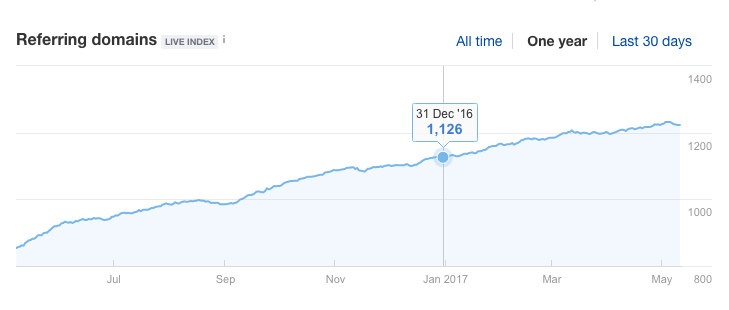
Similar to evergreen linking topics, they have the leverage of acquiring new visitors and potential customers from being able to rank for organic keywords. Given that they’ve been getting inbound links over time, they also have the tendency of improving its current search rankings - which can increase its lifetime link value.
For example, this page where I’ve acquired a backlink is getting consistent amount of links (see its link velocity graph).
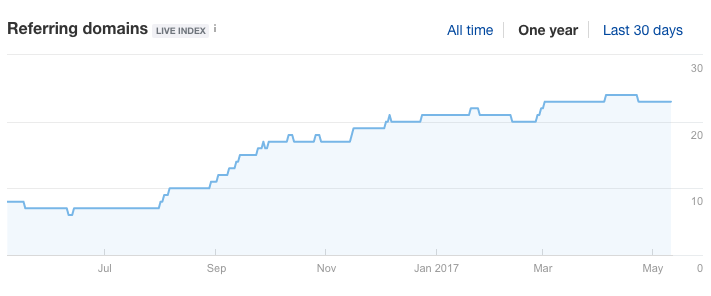 This has allowed me to semi-automate leads coming from the page itself (even after 1 year of being published).
This has allowed me to semi-automate leads coming from the page itself (even after 1 year of being published).
4. Temporal Links
Temporary links obtained through a “link renting” approach (similar to renting a house) have the lowest lifetime link value. Their value is predicated on the period of time the link remains sustained by the fees of the link buyer.
This type of links depreciates its link value, which can negatively affects the rankings of the content being linked to.
Imagine if a page is ranking within the top 3-5 spots for a target keyword and after a few months, 6 out of 10 of its temporal links have been removed by bloggers - this can certainly affects the page’s ranking.
While this hasn’t been proven by any study, the point in bringing this up is that temporal links can do more harm than good in the long run. Resources consumed for this type of links can be better off spent to links with high LTV.
4. Frequency of Updates
Determining the page’s frequency to updates or maintenance can help better assess its lifetime link value.
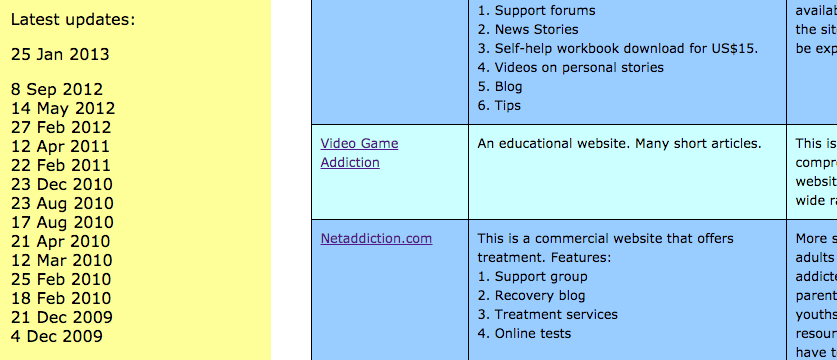
Static pages like resource pages with no updates since 2013 collects broken external links over time and is less likely being receptive to link request outreach pitches (some webmaster even planned to remove these pages).
Though these sites linking to 404s won’t be demoted by Google (as Gary Illyes answered Jennifer’s question), they are still perceived to provide a sub-optimal user experience. If you’re checking links on a resource page and find that most of them are broken, you wouldn’t take a chance to visit another link on the same page, even if it’s working in the first place.
No-longer-updated pages have low lifetime link value, as there are less likely to drive new visitors to their destination pages (their external links). Search engines won’t even try to rank these pages as they no longer updates information which are essential factor for search engines to decide which page deserve to rank for in search.
5. Link Neighbourhood
Checking the page’s link neighbourhood (other external links placed within the target page) is an imperative part of the link qualification process as it helps you better assess a backlink’s LTV.
A blog’s page with five commercial off-topic links is a low valued link neighborhood you certainly won’t get clicks from.
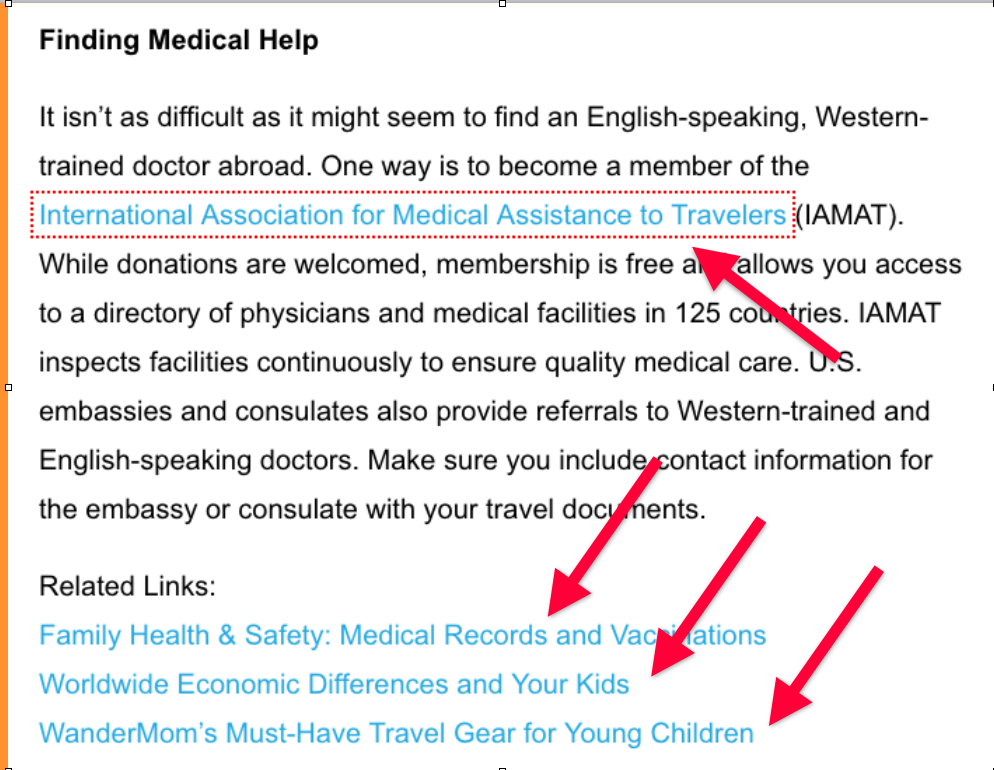
Check external links on the page and see if they’re mostly linking to commercial pages that aren’t thematically relevant to the content.
As a link building company, it has been part of our protocol not to acquire a link from a blog page with more than five external links and/or with a direct competitor link, unless the context of the page is a pure recommendation of services/products (i.e. top 25 productivity tools).
6. Indexability and Ranking Potentials
Indexability is fairly obvious, if a page isn’t indexed by search engines, it won’t certainly be found by target users. But there are potential link acquisition targets that are great opportunities on a naked eye view (well-designed and can potentially drive site traffic), but aren’t indexed by search engines in the first place.
To check if the site is actually indexed at the current time, you can use the command, site:domain.com and see if its pages are on search results (homepage should be at the #1 spot).
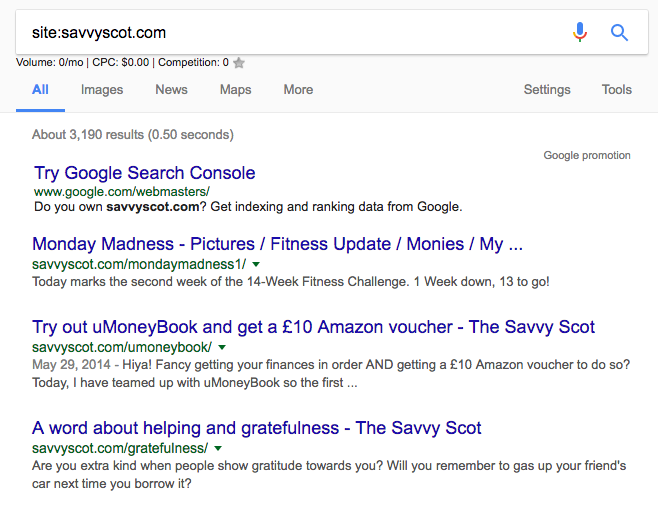
But more than that, target pages should at least rank in the first page for long-tail and/or low competitive keywords. The title tag of the homepage may not be worth assessing for in terms of rankings, as they may not be in the ranking positions yet. But going through its URL (target page), you should expect it to be visible in the first page of search results given that it’s targeting less competitive keyword than the homepage.
Ahrefs recently studied 3 million searches discovering the average number of keywords a page can rank for. They discovered that a page ranking for 10th, for example, can also rank for other 400~ related keywords.
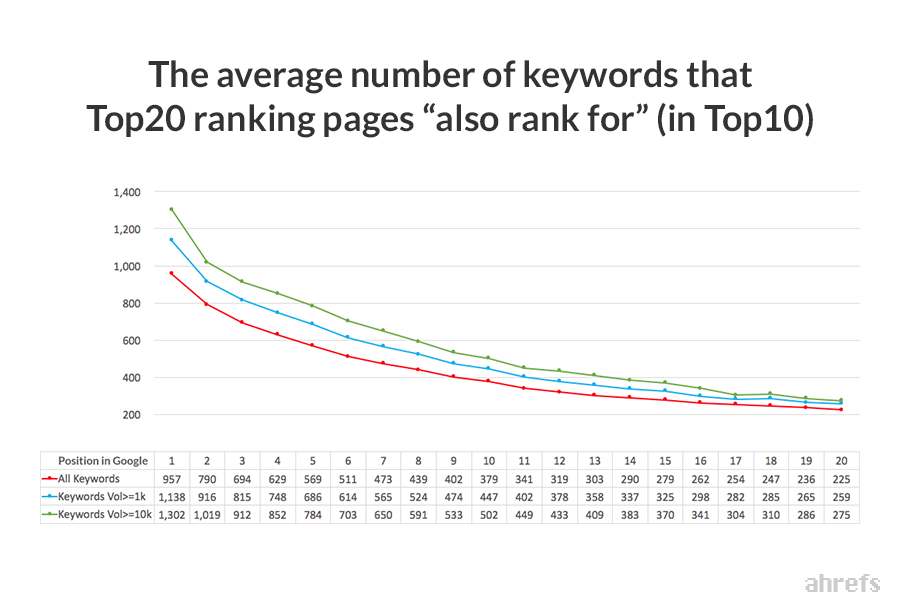 Content that are both indexed and ranking for target keywords are high-LTV pages that are worth pursuing for links.
Content that are both indexed and ranking for target keywords are high-LTV pages that are worth pursuing for links.
If you liked this post, you can follow me on Twitter @venchito14.
How to Build Authority Links to Your Website
What are authority links?
Authority links are links found on a webpage with an established trust and authority to drive targeted traffic to a website that can help the brand achieve its business objectives.
Getting these authority links is tough. It requires hard work, creativity and persistence to find, pursue and connect to publishers and industry linkers who are interested in citing or referencing your content as a trusted resource to follow.
Link building is not for the faint-hearted marketers.
After all, if a link can be easily acquired by everyone else, it shouldn’t be called an “authority”.
However, despite its difficulty, online marketers still pursue this type of links as it can positively impact a website in many ways, such as:
- Sending targeted traffic to your page
- Generating leads and sales from referred traffic
- Improving search visibility of your page by making it rank for industry keywords
- Providing more link opportunities to your content (organically from researchers who can potentially cite you as a credible source of information)
- Creating brand awareness (as you’ll be linked alongside with influencers and big content creators).
“Authority” is pretty much subjective depending on what factors you consider.
But whether it is relevance or benchmark metrics such as Ahrefs DomainRank, it is important to understand what types of links are deemed to be authoritative. Given that this will be the roots of your link building approaches - your “how” in getting links.
Types of Authority Links
Links from .edu and .gov sites
The legitimacy of an educational and governmental institution/organization being able to register a .edu/.gov domain is a way of the Internet preserving the authority and trust of this type of websites.
Although there remains a debate over the true value of .edu and .gov extensions, I strongly believe that what makes these sites authoritative is the information found on their pages. Incorrect, spammy or misleading details may lead to some drastic consequences on its end users (website visitors).
Authority .edu and .gov sites are hard-to-replicate links. Restrictions as to how relevant your page/site is to their own resource page make it more difficult for your competitors to get the same types of links - unless they’ve created a better version of your content or is associated in the same organization your brand belongs to (e.g. for local professional organizations).
Links from ranking pages for thematic keywords
The most powerful links on the web are the ones that can directly send relevant traffic to your site.
Ranking pages for targeted industry terms are great sources of new traffic from searchers looking for relevant information.
Acquiring links from them can drive consistent visitors to your site (not just one-time off - as what happens to a one-time guest post publishing).
Here are a few tips to getting links from rankings page:
Target relatively new resource pages. They are more receptive to outreach pitches than old links pages that haven’t been updated for year.
Given that they have just started curating topical resources/references, they are open for resource link requests.
Start your search with queries like, “inurl:resources “keyword” or “inurl:links.html “keyword”. Then set a time to past year/custom range (Tools - Time).
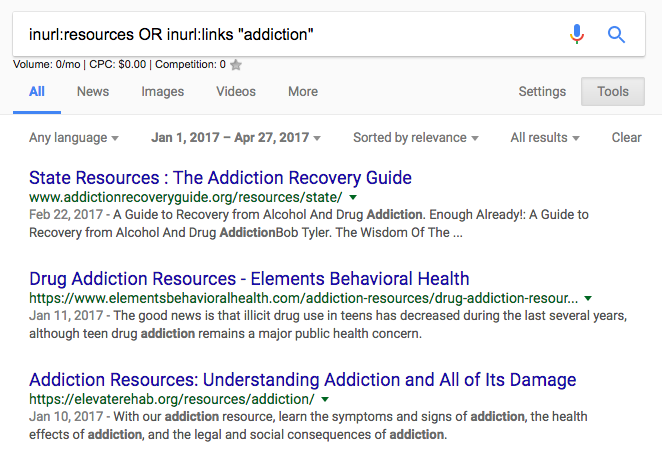
Contribute early to new industry publications. Investing early on topically relevant blogs (with high potentials for audience growth) by supplying them with regular content is a great technique to scale your link development efforts.
Because you’ll get higher approval rates as a columnist to contribute to low-authority (with high velocity for growth) publications compared to a high-tier news site in your industry.
Check the blog’s potential for growth using Ahrefs or SEMRush organic data.
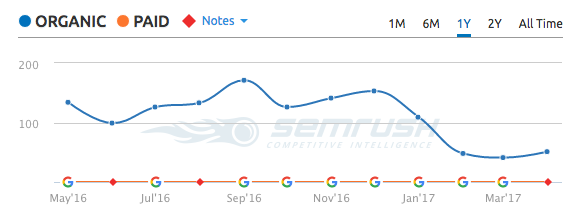
Begin this approach with your typical guest blogging queries. Then do the same process above (set a time to past year/custom range) to filter recently published “write for us” pages.
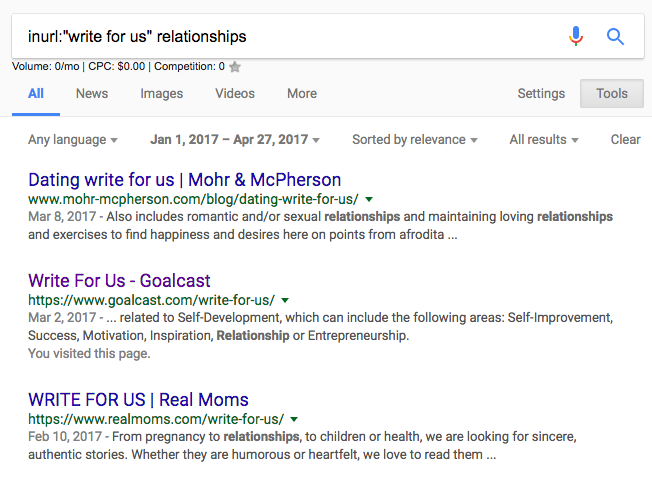 (hat tip to Jason Acidre for this technique)
(hat tip to Jason Acidre for this technique)
Further reading: Definitive Guide to Guest Blogging
Offer to update a static page. Informational content ranking for highly-searched terms should constantly be updated to satisfy its searchers’ intent, especially if the content requires the timeliness of the information (i.e. 2017 trends/updates).
This is where you can add value to the content creator by helping him update the page with new information and by adding other content formats (visuals, transcripts for video/audio, tables, etc..) - needed to make it 10x better than its competitors.
Links from top-tier news sites
Getting featured on A-spot blogs (media sites) can’t easily be replicated by your competitors because it requires relationships to make it happen.
If you have built connections with existing contributors from top-tier news sites, it’d open opportunities for your brand to be referenced as an authority expert in the industry.
Links coming from them (top-tier news sites) like Forbes is a great way to establish your brand’s authority.
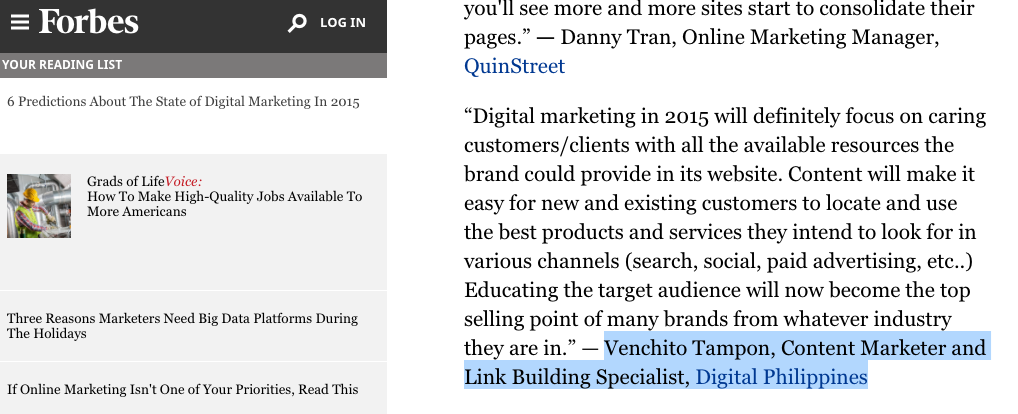
You can also add social proofs to your signature or email pitches when reaching to mid-level or high-tier blogs for content partnerships to build your site’s
Links from topically relevant websites
Consider a prospect page’s relevance to your site above everything else. You’ll find pages hosted on domains with low Moz DA but should be considered as highly valued link prospects since they can pass human’s eye tests - great user experience, satisfying content and with promising search traffic growth (which can be measured using SEMrush/Ahrefs).
See this DA11 finance blog as an example.
 I liked the three primary reasons Jon Cooper listed why SEOs and link builders should consider prospecting for relevant blogs/sites:
I liked the three primary reasons Jon Cooper listed why SEOs and link builders should consider prospecting for relevant blogs/sites:
- Looking at relevance gives you more room for larger pools of link prospects.
- Relevant links have a bigger impact on the algorithm.
- Webmasters are more likely to award you with a relevant link since it makes sense for their audience.
You need to start prioritizing relevance today as your primary metric in link prospecting.
Links that generate business conversions
Links that are sending qualified conversions to your website are link types and sources you should replicate over time - as they directly affect your online business’ revenue growth.
Aim to get recurring links from these websites to increase more assisted conversions generated in your brand.
On Getting Authority Links
Authority links are hard to get. But if you’ll able to acquire them for your site, it would tremendously impact your site’s search rankings - helping you dominate the market you are competing in.
Authority link development requires either branding and/or content.
Summing them up is a powerful combination for link authority.
1. Perceived Branding
There are online businesses that don’t need 10x content to start getting brand awareness and establishing brand authority, as they have built it already using offline marketing platforms, such as advertising on billboards, television ads, and other offline marketing channels.
They have branded searches which enable them to generate leads and sales offline without having to depend purely on organic industry rankings.
If you are a consultant or an agency, getting clients who are widely known in a particular niche is a clear advantage on your end to develop authority links.
Because people are aware of the brand’s name, pitching publications and authority sites (.edu and .gov domains) for guest blogging, resource inclusion and broken link building are much easier to facilitate.
Ways to use perceived authority to get links:
A. Link reclamation
Find publishers who have mentioned your brand or product but haven’t linked to you. You can use BrandMentions to track them.
Then politely pitch them and ask for link attributions.
This technique has been covered many times, so here’s a guide you can check out that walks you through the entire process.
B. Interview opportunities
Use your branding to cover more interview opportunities wherein you can also obtain authority links to your site.
Make your existing press mentions and features of your brand as social proofs when pitching to industry publishers who’re looking for guests on their show (podcasts). The more credible you are as a brand, the higher the probability they’ll get you (or your client) as a guest for their show.
C. Incentivize social sharing in exchange of linking
If you’ve had a huge fan base in your social accounts, you can start using it as a value proposition when reaching out to bloggers in your space. Ask if they’d be willing to be featured on your social profiles (as long as their content feature provides useful information). In exchange, get an authority link from one of their pages.
D. Speaking gigs for natural linking opportunities
If your client is into public speaking, it’s best to check if you’re getting natural authority links from speaking pages/profiles of event organizers’ websites. There’ll be times where they’ll be linking to broken URLs/domains.
You can also monitor publishers who link to your client’s slide presentations and Slideshare profile and ask if they can cite your client’s website as a source.
 Chris Dyson wrote a guide on how to reclaim links from content creators that used your visual assets.
Chris Dyson wrote a guide on how to reclaim links from content creators that used your visual assets.
More reading: Using Brand Building Strategies to Improve Link Building
2. Content-based Link Acquisition
If perceived authority is missing in the formula, you can still get authority links by producing 10x content assets.
Smaller brands can win over big brands with an effective strategy to produce more content assets that can attract organic links.
As coined by Rand Fishkin, 10x content simply refers to content that is 10 times better than the best result that can currently be found in the search results for a given keyword phrase or topic.
Jason Acidre wrote a great piece on his own 10x content creation process (I advised you to check it out).
Here are a few effective techniques to acquire authority links using content:
A. Broken dead domain link building
Broken link building is a concept of pointing out broken links to webmasters, with the hopes that they’ll be open for requests to add your link, whether as a direct replacement for a previously broken link or as a new addition unrelated to the broken ones.
Here are some useful resources to get started with broken link building:
- All-in-one broken link building workflow
- The broken link building bible by Russ Jones
- Inverted broken link building strategy by Ahrefs
Maximize this link building approach further by observing what other similar resource pages have been getting organic links (quietly) in your space. They’ve gotten links you haven’t acquired yet that I’ve found, in most cases, can’t easily be found through Google search.
Track dead content (broken links) on resource pages using LinkMiner.
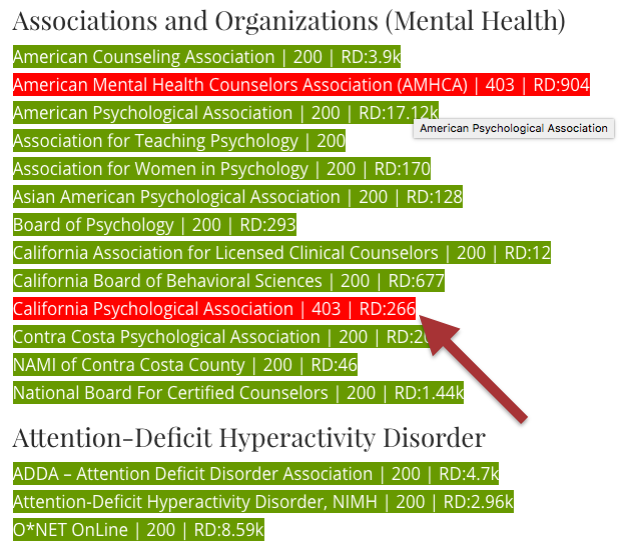 Set the options to display the number of referring domains for each external link.
Set the options to display the number of referring domains for each external link.
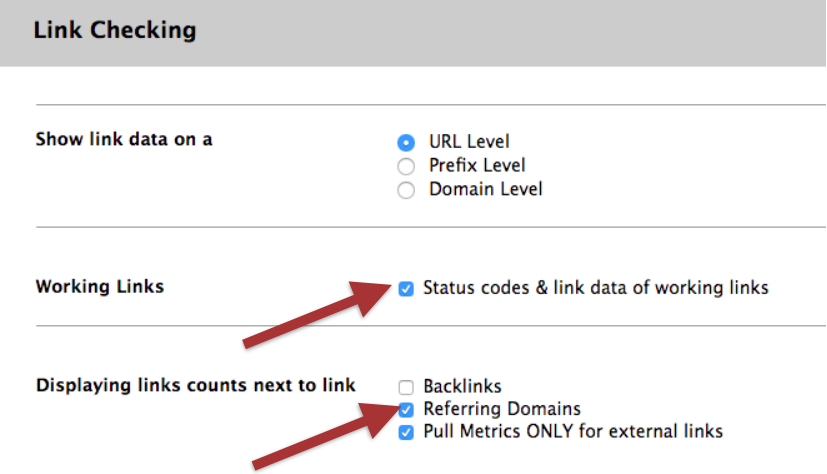 Check if the link is broken and if it does, do research further if it’s just a specific URL or prefix that isn’t working or the whole domain itself.
Check if the link is broken and if it does, do research further if it’s just a specific URL or prefix that isn’t working or the whole domain itself.
For instance, this video addiction content that I’ve found on a links page is part of the whole domain that isn’t working.
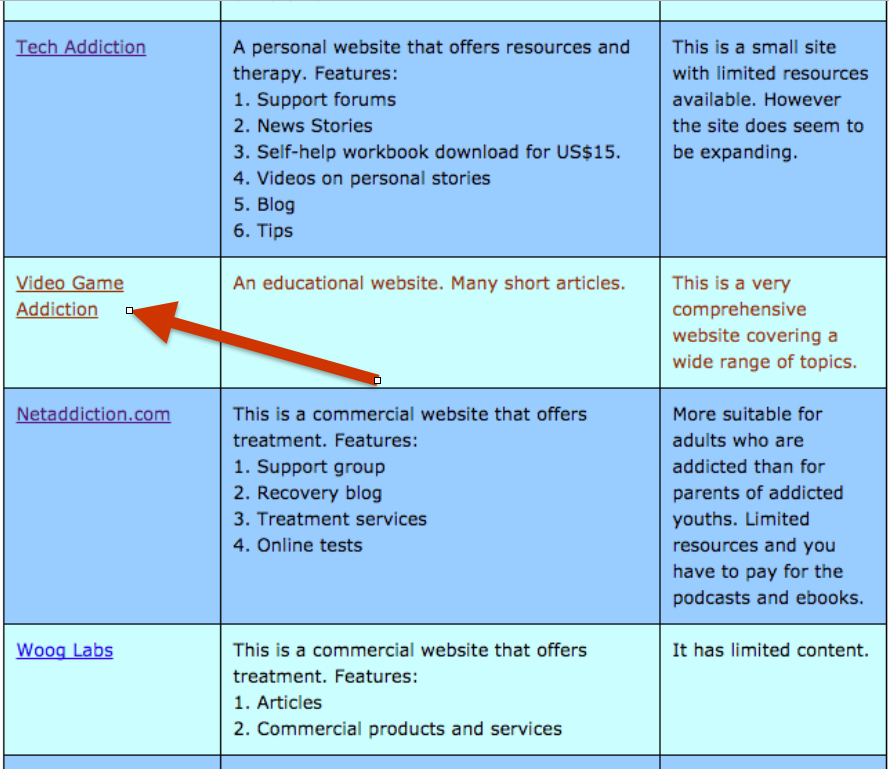
Gather resources/links pages pointing to the whole domain, not just to the specific broken content. Because there are other content in the site that gained high-authority links from other linkers as well - which provides you more link opportunities at one hand.
You can filter the results by link type (educational) to quickly extract .edu resource pages. Also, do quick searches for “link” or “resource” on Ahrefs referring domain search bar to easily get the same type of link opportunity (links pages).
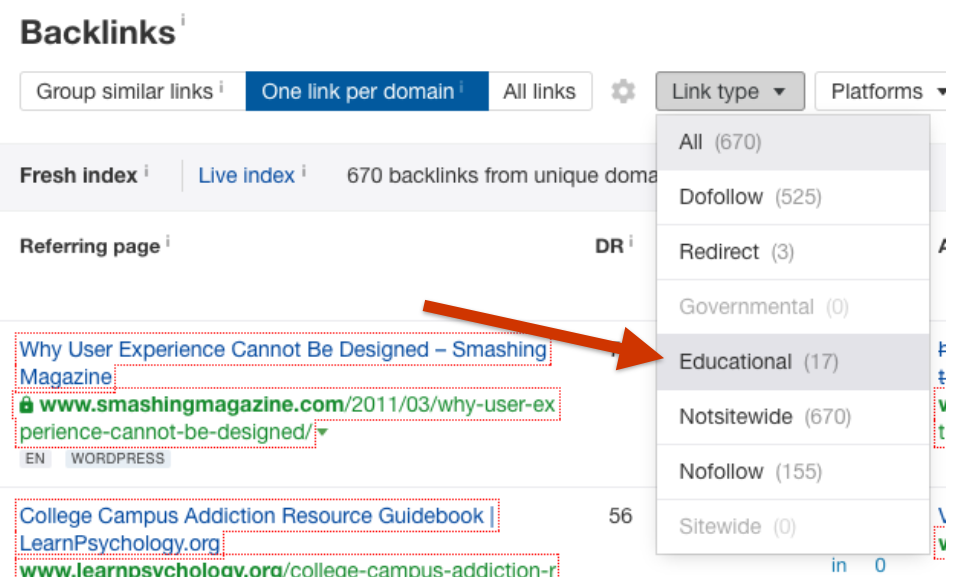
Reach out to webmasters letting them know of the broken content they’ve linked to from their pages. Then suggest your relevant content as a replacement to their defunct link.
To increase the efficiency of your outreach management work, it’s best to stalk your A-list sole operator webmaster and see if they have social accounts you can pitch to - straight to get their personal email addresses.
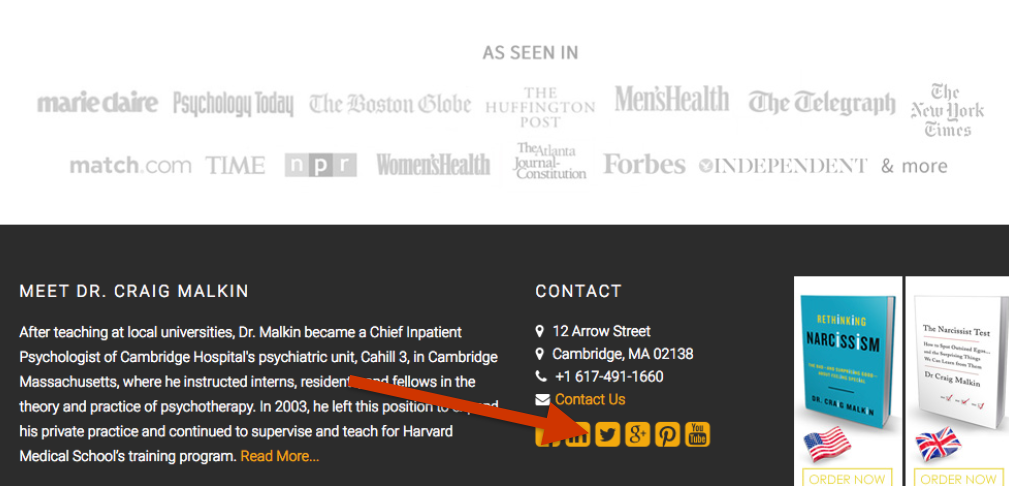
I’ve found this effective for personal blogs (with only one webmaster/operator) and for sites with no visible email addresses.
Instead of sending follow-ups to receive a response, you can directly ask them for a contact email they regularly use. Because other webmaster has more than one email address - you may be pitching to one that isn’t working anymore.
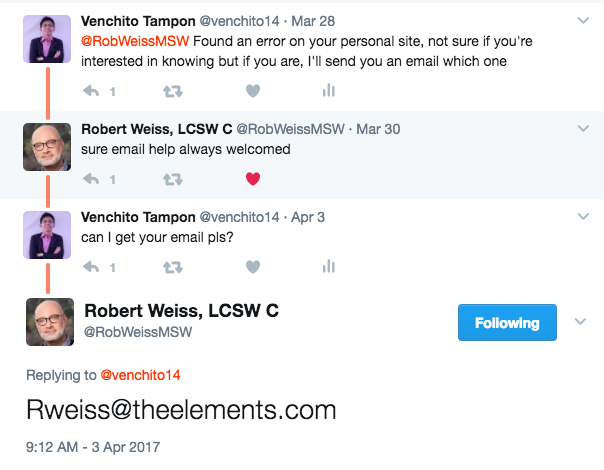
Plus, this allows you to see their interest to get help from you in providing errors found (broken links) found on their webpage.
Then acquire links:
 B. Reverse engineer new content assets with highest link growth
B. Reverse engineer new content assets with highest link growth
Reverse engineering other people’s content assets has been a standard practice in the link building space.
Since publishers/content creators have linked/shared a competitor’s content (or a website with a similar content of yours), you’ll have better chances of acquiring a link to your content - especially when your content is 10x better than what your competitors have.
Start by finding competitors’ content that are similar to the assets you already have.
But don’t stop from there. Find other non-competing but relevant websites with high-performing industry guides (those that received a substantial amount of high-quality backlinks).

Analyze their backlink growth further by checking the page’s link velocity. This approach allows you to get insights on how long have they’ve been building links or have been picking up links organically.
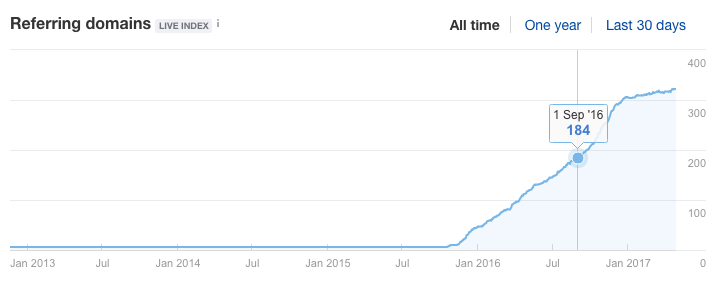
Because if they’ve acquired authority links just recently, their existing linkers are still at the stage of updating their pages/sites. When you reach out to them, you’ll have a higher probability of receiving positive responses.
You might also find other linkable audiences where they’ve been able to secure links that you might as well consider for link prospecting.
C. Linkable market analysis
Linkable audience is a group of resource curators who would benefit from specifically tailored information on a topic.
Starting a link development campaign by identifying linkable markets in the space can give you a better idea if a particular content topic is worthy to pursue for content creation. It is a guarantee on your end that there are audiences willing to link to your content asset, once it’s been created.
There are two ways to assess linkable markets in your industry:
Check the number of unique referring domains to ranking pages for industry terms
You can use Mozbar to see if there are pointing links to pages ranking in search results.
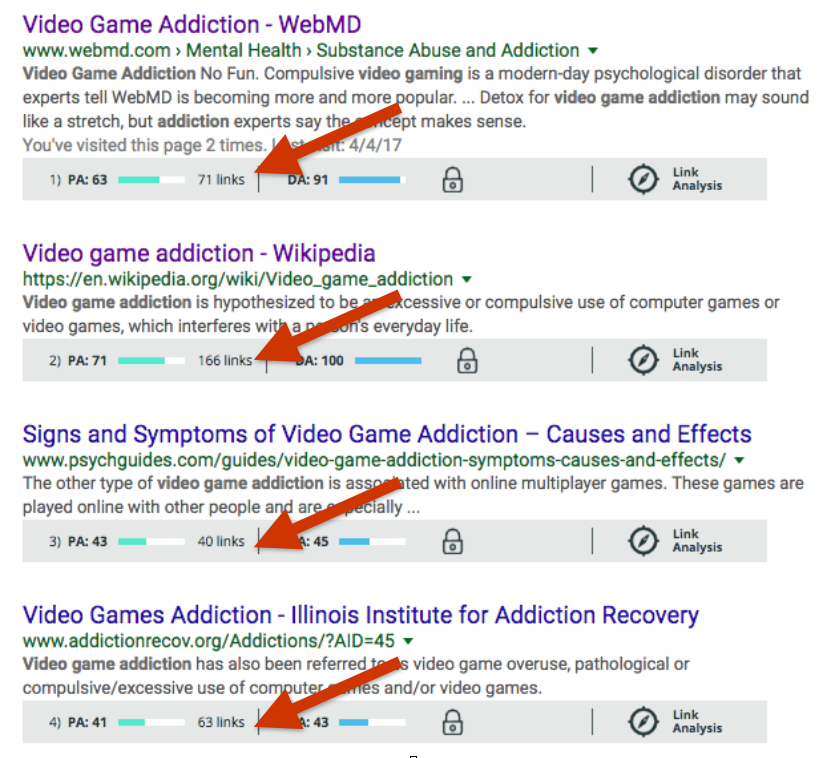
You may have to analyze further these links to see if they’re coming from legitimate websites/pages.
Intersect existing linkable audiences to your brand’s theme
Garett French created a list of 601+ linkable audiences whom you can serve with your content. If you can intersect your brand’s mission with different linkable markets, you’ll be able to generate more link opportunities for your website.
For example, this drugs rehab site published several pieces of content targeting different linkable audiences.
1. A Substance Guide for Parents
Linkable audience: Parents of teens who are struggling with substance/drugs.
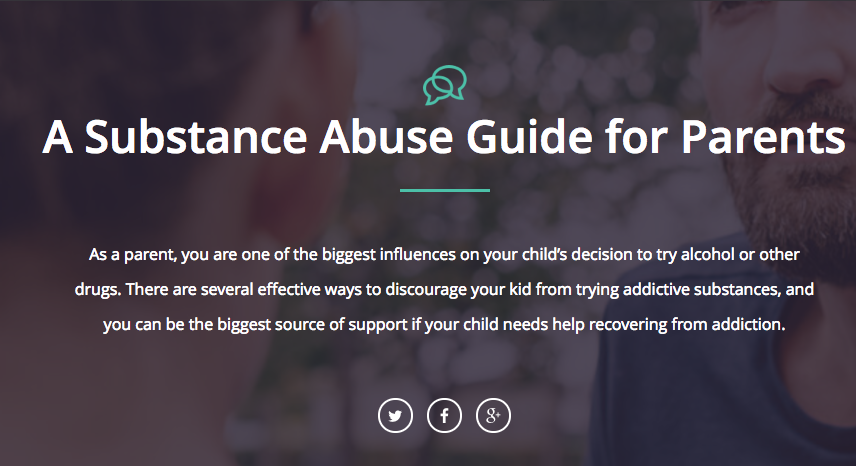
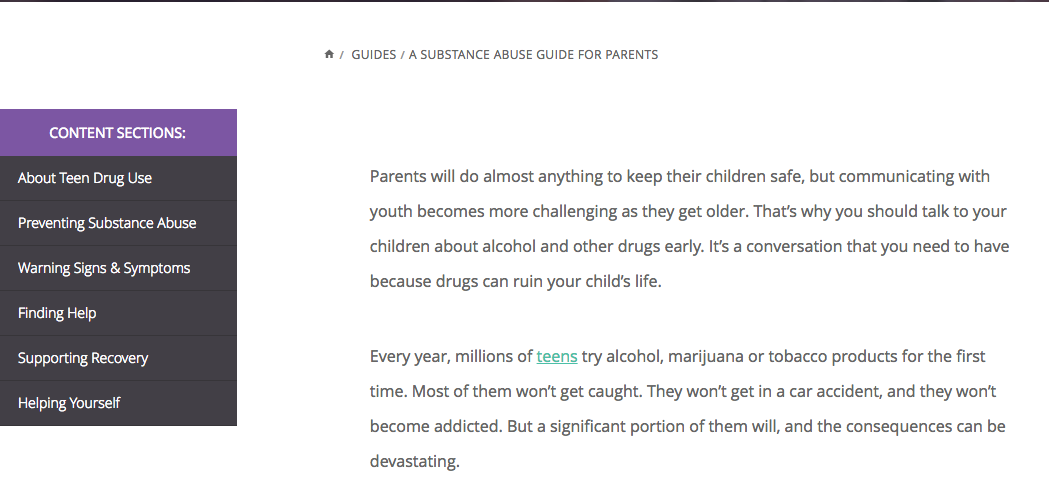
2. Bullying and Substance Abuse: Who It Affects and Why
Linkable audience: People concerned about bullying in schools.

3. Degrees for Mental Health and Addiction Professionals
Linkable audience: Job seekers in the mental health and addiction niche

Linkable audiences:
- Parents of LGBT teens
- Parents of LGBT adults

You may notice that these audiences served by resource curators (not necessarily bloggers/journalists, etc..) fall into one of these categories:
- a person in need, or a person who cares for a person in need
- a person seeking out information
If your clients have content pieces that are targeted to specific linkable audiences, you’ll have higher chances of acquiring consistent amount of authority links every month.
Further Reading:
- Link Magnetism - How to Create an Authority Site That Attracts Authority Links
- Earn 50+ Authority Links Per Month
The Definitive Guide to Guest Blogging
For more than a decade, guest blogging has been by far one of the scalable link building tactics used by search marketing agencies, bloggers and business owners to get backlinks for their own websites.
Also known as guest posting, guest blogging is the practice of contributing a content piece to another blog, whether that piece is an article, visual asset like an infographic, video, or any other content formats that will serve the audience of the blog (guest blog).

There are many benefits guest blogging does for your website (aside from getting a backlink):
-
- Serves as a social proof you can include on your site’s landing pages (e.g. As Seen On or Featured In) or on your outreach emails when reaching out to other industry publishers (e.g. I’ve contributed articles to X, Y, and Z).
- Increases your brand followers in your social accounts coming from the other blog’s existing audience, which will eventually help amplify your future content assets.
- Generates assisted conversions (potential customers/clients) to your website.
- Improves search visibility of target pages for keywords you’re trying to rank for.
In this post, I will share my typical step-by-step guest blogging process from finding guest blog opportunities to tracking results of guest content.
How to Find Guest Blogging Opportunities
In guest blogging, your first initiative is to identify your market audience.
To help you define it, here are some questions you can ask yourself:
-
- Who are the direct consumers of my brand, those who will primarily benefit from my products or services?
- What are the other industries I can tap onto aside from my primary niche? (Brian Dean referred it as “shoulder niche”).
If you are a marketing consultant, you can ask your clients or get some data from their sales data for you to determine their target audience.
Check if your preferred industries have enough blogs to target for guest posting. You can be in a very defined niche, i.e. snoring, where you might only find a few blogs to pitch guest posts to.
In this case, you can prefer page-to-page relevance over domain-to-domain relevance. Here’s an image to explain what this means:
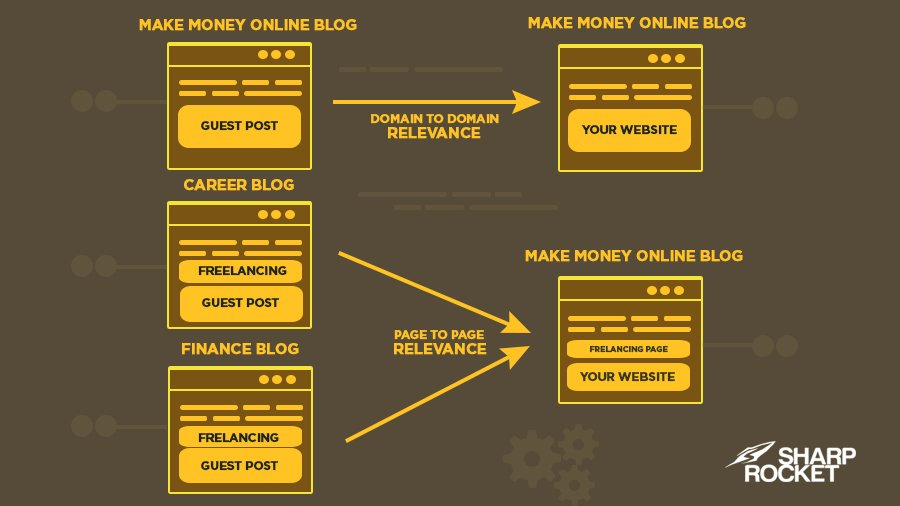
Once done, proceed to finding guest blogs.
There are many sources out there that you can use to come up with a list of websites to target for guest blogging. To name a few:
-
- Google search (using search queries such as inurl:”write-for-us” “snoring”).
- Portfolio of industry guest bloggers (“guest post by” “Ryan Stewart” - fastest way of generating a list of guest blogs by checking blogs where an active guest blogger contributed posts to)
- Twitter search (using search queries such as “guest post” “snoring”)
- Contacts of other industry publishers (exchange list of guest blogs with a niche blogger).
Recommend resource: Search Engine Queries Cheatsheet
The best way to save time in guest blog prospecting is to qualify websites as soon as you landed on them.
1. Check estimated organic traffic
You want to contribute content to a blog that markets itself. This ensures that your guest post will have a high lifetime link value - which means that it remains to provide direct benefits to your website even after the first burst of traffic it’ll get once published.
Use SEMRush to get an idea how many organic visits a particular blog gets every month (estimate).
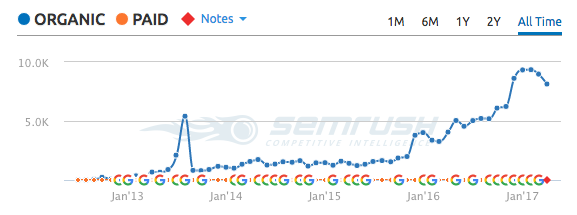
Tip: A sudden drop in the blog’s estimated organic traffic may indicate penalties it received in the past.
2. Review the blog’s engagement status
The average number of quality comments a blog receives for his articles is a good indication of how engaged his readers are with his blog.
See if the blog has a substantial # of comments by simply checking his recent posts.
3. Authority and trust
How authoritative and trustworthy a site isn’t accurately measured by metric tools available in the market such as Moz’ DA and Ahrefs’ Domain Rank.
However, having a benchmark (e.g. DA30+) gives you the scalability you need to quickly qualify blogs as you landed on them.
Tip: Don’t use DA/Ahrefs DR for blog qualification alone. There are a number of blogs with low DA but have a high estimated search traffic (as measured by SEMRush’ SEPrice)
How to Pitch Guest Blogging Ideas
Your next step is to pitch potential publishers with content ideas of your guest posts. Effective guest blogging involves brainstorming for the right content ideas suitable for a guest blog.
Here are a few ways to generate guest post ideas:
-
- Topics listed in guest blogging guidelines (do a Google search for site:exampledomain.com guest blog guidelines - ensure their preferred topic ideas is your first priority).
- Blog’s previous articles (site:exampledomain.com “topic”)
- Blog’s categories (for page-to-page relevance)
- FAQfox (most commonly asked questions)
- Buzzsumo (most shared content in the industry)
- Ahrefs (most linked-to-content based on the # of unique referring domains)
It will help if you organise a list of guest blogs together with the following details:
-
- Domain Name
- DA/Ahrefs DR
- SEMRush SEPrice
- Contact details (name, email address/contact form) - see how to find email addresses guide
- Guest blogging guidelines link
- Content idea #1
- Content idea #2
- Content idea #3
Pitching Best Practices
Whatever outreach platform you use, it is an effective way to personalise your pitch while being efficient in sending outreach emails.
Always address the blog’s owner with his/her name (e.g. Hi Andy).
Include three content ideas (customized for the blog) in your outreach email.
Provide social proofs such as links to your recent guest posts, more importantly, if you’re trying to pitch to high-tier industry blogs. Write a few sentences how these guest posts did performed (# of comments and social shares they received).
Compliment the guest blog when it’s only applicable such as when the blog has a good webpage design). Be authentic at all times.
Pro Tip: Prioritize your guest blogs based on their authority and trust. You can personalize high-tier guest blogs a little bit more by providing feedback or opinion to one of his recent blog posts.
Further Reading:
Definitive Guide to Blogger Outreach
Blogger Outreach Guide by Ahrefs
How to Write Guest Posts
Drafting is important in guest blogging as it basically guides you (or the content creator) on structuring the guest post based on:
-
- Level of audience the guest blog caters to (beginners, intermediate, advanced)
- Type of audience they’re writing for
- Type of content they’re writing about (list post, case study, tutorial, etc..)
The topic idea that has been accepted by the blog owner should be well-written in the format and context of the details listed above.
It is also important to check the blog’s guest blogging guidelines for other important information, such as the tone and person point of view, that must be taken care of while writing the guest post.
There are two ways to succeed in writing a guest post: do-it-yourself or outsource it to a freelance writer.
DIY (Do It Yourself)
If you want to have a full control over the content, it is a great idea to write the guest post by yourself.
One approach you can consider is dividing the guest content creation into three different phases (drafting, researching and final writing).
You can schedule each phase on different days to help you focus only on one task.
Use Trello to manage your tasks. Personally, I create boards for To Do, Doing and Done to streamline my process in content creation.
Tip: Invest in grammar checking tools like Grammarly to semi-automate proofreading and ensure the quality of your guest posts.
Outsource it to a Freelance Writer
For agencies, one option to scale content creation in guest blogging is to hire freelance writers.
Websites like Upwork, Onlinejobs.ph (Filipino writers) and Facebook writing/blogging groups are sources where you can find quality writers.
Another approach that you might want to consider it is reaching out to bloggers and publishers in your industry and ask if they are doing freelance writing. They may charge higher than the usual freelance writer but the quality of writing will best suit for the guest blog.
Editing, Revisions & Final Publishing
Before submitting your guest post, it should be part of your process to check if there are any corrections that must be made to avoid early rejections to your content by publishers.
For the author bio, make sure you include external links pointing to your target page (homepage or a linkable asset you’re trying to increase visibility with).
Request to publishers, if possible to include your author bio at the end of the post instead of placing it in the usual “author bio box”. In my own experience, contextual “author bio” links gives more link value than a link from an “author bio box’.
Tip: Include internal links in your guest posts pointing to a relevant content within the guest blog. Having the webmaster do less work is a big plus.
Some publishers won’t allow you to link to a conversion page (e.g. product page) - in this case, you may include a link to a category page. This is a good approach if you want to flow link equity down to your deeper pages, such as your product pages.

Another approach that you can text is including a “guest post lead” or “expanded guest post” at the end of your post.
Expanded guest post or “guest post lead” is an extension of your “guest content” that provides more information on the topic not included in your content (e.g. 3 more advanced tips on X, free cheat sheet, data/report or summary that covers the topic in more details, etc..).
Below is an example of an expanded guest post that generates a good number of email subscribers for SharpRocket.
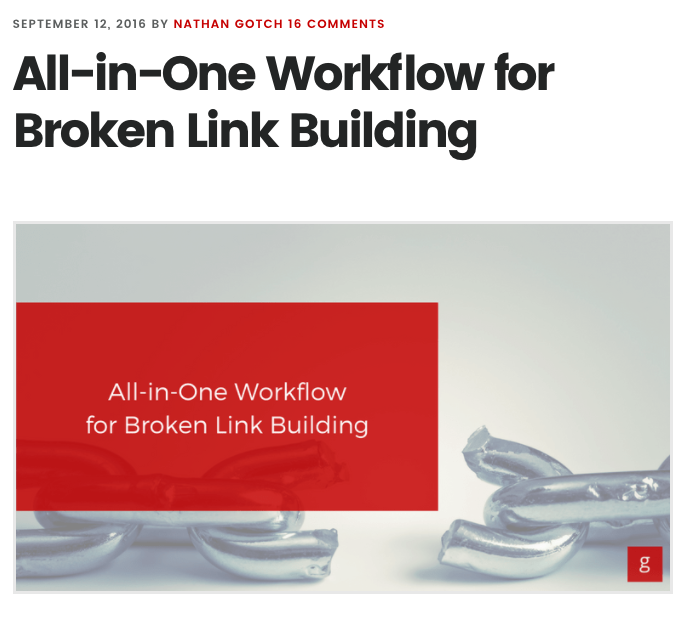
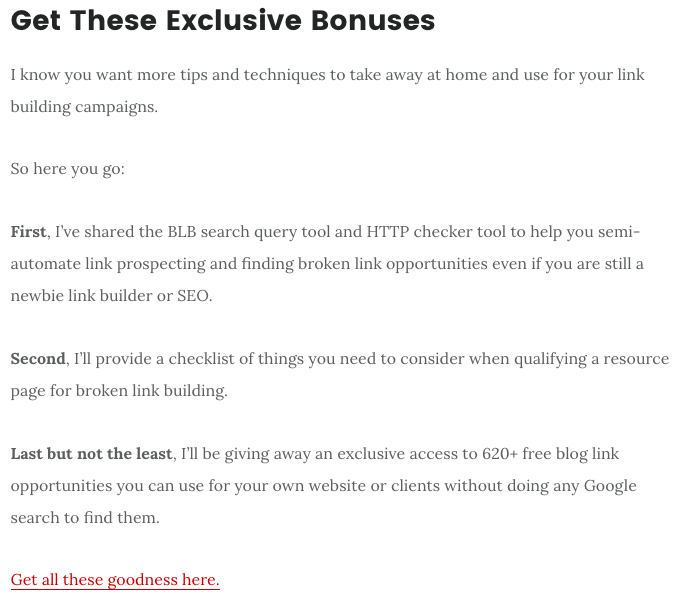

Personally, I prefer to create a “custom page” to be linked to from a “guest content” (see example below).
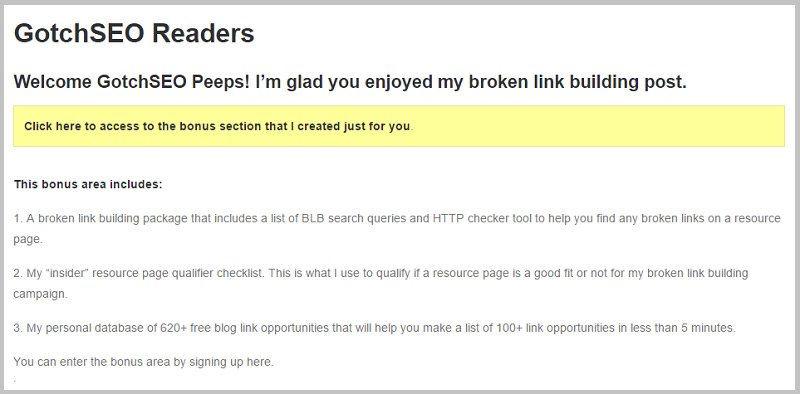
When you have the content ready for submission, it is best it to send your post in HTML aside from directly attaching the document in your email. This eases the work of the publisher to upload the whole content and properly link to certain pages.
How to Promote Your Guest Posts
Publishing your guest posts is only 50% of the battle.
It is best to promote your “guest content” once published on the target blog.
Here are my favorite ways to put more eyeballs to guest posts:
-
- Write a “promotional email” sharing your latest guest content and send it to your email subscribers.
- Get more visibility by distributing your content on different social platforms.
- Link to it from other external web content assets, like guest posts on other industry blogs.
- If budget fits, invest in promoting a guest post through Facebook advertising (only when you have secured it on a high-authority blog).
How to Track Results From Guest Blogging
No one succeeds without tracking results of work.
Identify which of your guest posts helps achieve your business objectives. It will be more beneficial for your brand to land more solid links from them (and more brand exposure) by regularly supplying with “guest content”.
Create a Custom Report in Google Analytics (Customization - Custom Reports).
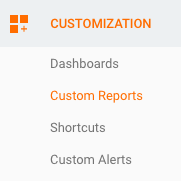
Click “Source” and “Landing Page” for Dimensions and “Goal Value” and “Users” for Metrics.
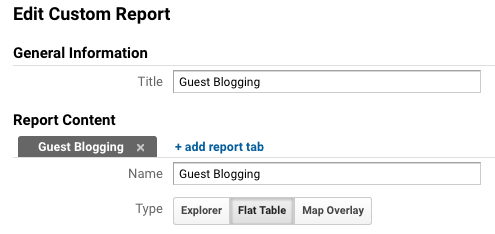

For Filters, click “Source” and type in the domain name for exact value.

Then click save.
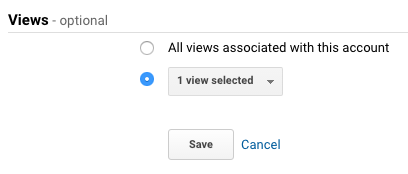
You will generate a custom report wherein you can get insights on the following:
-
- Number of users each guest post received for a certain period of time.
- Which pages (Landing Page) users landed on coming from the guest blog.
- Business value these referral visits/users generate on your website (depends on your custom goal values).
If you have setup a custom lead magnet/page on your website where referral users from guest blogs will land on, you can check how many referral visitors have converted into email subscribers.
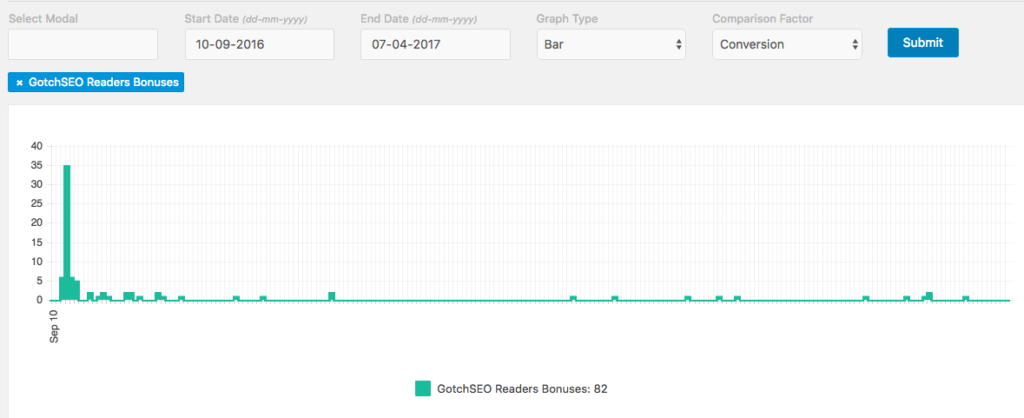
Personally, I use ConvertPlug to create lead magnets and to track the # of new email subscribers these guest content pieces generated.
Tip: It would be a best use of time to only create a custom lead magnet if the guest blog has high potential to drive converting visitors to your website. I suggest you check how many estimated organic visits the guest blog receives on a monthly basis using SEMRush.
Leverage new opportunities from guest posts
To further see the business value of your guest posts, check if there are referring links to your guest posts as well as positive mentions of your brand (right after these guest content have been published).
Reach out to these new linkers for opportunities to collaborate on content (guest post) or get exposure in other ways (podcast interview, getting featured on link roundup, etc..).
TL;DR
-
- Prospect for guest blogging opportunities using search engines (Google), Twitter and/or reverse engineering industry guest bloggers.
- Check the blog’s estimated organic traffic using SEMRush.
- Check if the blog receives quality comments on his content.
- See if the blog has an authority and trust using metrics like Moz’ DA or Ahrefs’ DR.
- Pitch bloggers/publishers with three or more customized guest post ideas for their blogs.
- Create a draft of the “guest content” based on the chosen topic idea of the webmaster.
- Build the content either by doing it yourself (DIY) or outsourcing it to a freelance writer.
- Ensure quality of content by checking its information as well as add important details such as author bio, external links to your target page and internal links to guest blog’s relevant content.
- Promote your guest content to your email newsletter, social media accounts or on your other guest posts.
- Track # of visits and conversions generated from your guest blogging campaign using Google Analytics and conversion monitoring tools like ConvertPlug.
Are Private Blog Networks (PBNs) Worth It In 2017?
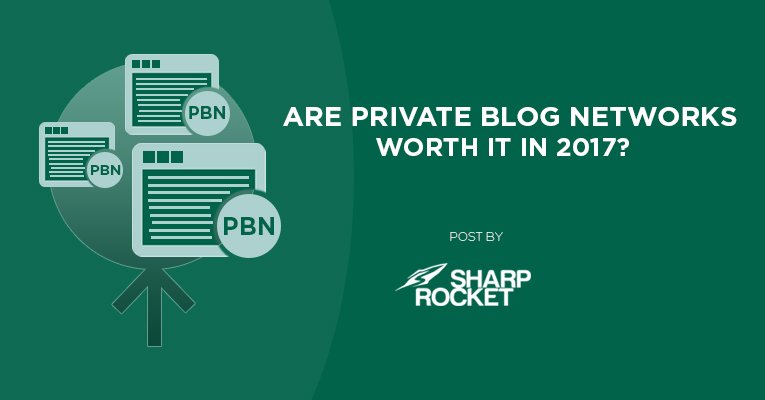
I always get asked by SEOs, particularly those who have their own agencies why I’m not using PBN as my go-to-strategy in link building.
I’m not an anti nor pro private blog networks. If it works for you and you told your client the risks of doing it, that’s fine. Otherwise, you’re blindsiding your client.
This post reveals data of the return on investment of a private blog network.
I received 75 responses to the survey I did this month on everything about private blog network.
Let’s see what we’ve gathered here.
Note: This survey was done to gather simple data on the cost and time investment they take them to some immediate rankings for their websites. This is not the end all and be all of ROI on PBNs.
How many websites do you have in your PBN network?
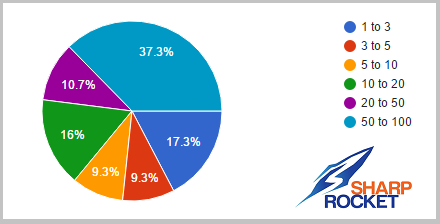
Respondents are heavily engaged in a Private Blog Network, with 37.3%, (28 of them) have 50 to 100 websites in their private blog network. A few reached out to me that admitted they even have a larger size, 100 or more websites in their database.
How much does it cost you to start each website? Including Domain, Private Whois and Hosting plus a few articles to start.
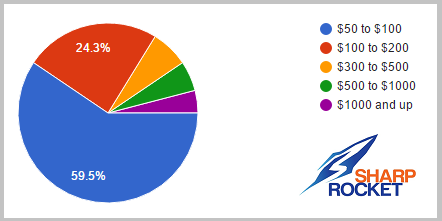
Similar to any website creation and development, private blog network owners take the time to setup a domain, Private Whois and hosting plus creating a few content pieces or pages to get started with it.
A whopping 59.5% of respondents invest $50 to $100 for each of their websites.
Among the 59.5% who invested $50 to $100, 15 of them have 50 to 100 websites, only 11 have 1 to 3 websites.
If you do the math, the highest prices might go between $2500 and $10,000 total setup cost! It’s a big amount for those who are just starting out and want to get immediate results.
How many hours every week do you spend for web development, content, plugins, etc.. for each website? – maintenance
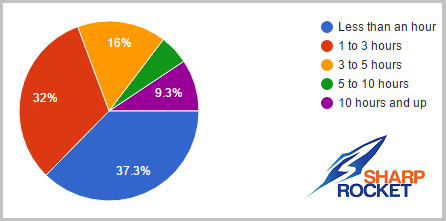
Let’s get to know the number of hours private blog networks owners spend for each of their PBN sites.
Over 37.3% of them spend less than an hour every week to maintain each of their websites. It may include adding SEO plugins, developing each webpage, publishing new content and other maintenance activities.
Out of 37.3 equivalent to 28 respondents, 10 of them have 50 to 100 websites while 6 only have 1 to 3 websites.
When you do the math, the longest time a PBN owner spends each week for all his websites ranges between 50 to 100 hours! It amounts to a full-time day job.
Do you outsource content for your PBN sites?
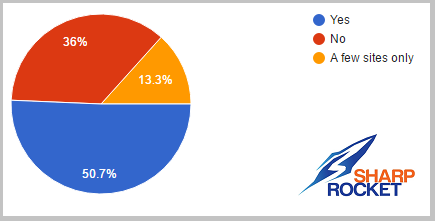
More than half of the respondents outsource their content creation tasks to freelance writers. If they have tons of websites (50 to 100 or even more), it’s wiser for them to outsource content as it is obviously time-consuming.
If yes, how much do you invest for outsourcing content for each site? (61 responses)
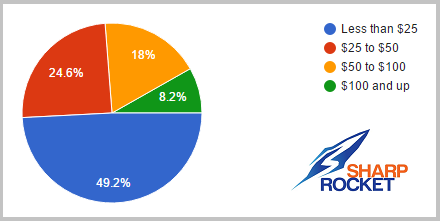
Among the sixty-one respondents, 49.2% or 30 of them invest $25 for the content of each of their sites, only 8.2% or 5 PBN owners spend $100 and up for outsourced content creation.
Out of 30 private blog networks who spend $25 content investment for each site, 9 of them have 50 to 100 PBN sites, only 3 have one to three websites.
If you do the math, the total cost for outsourcing content for PBN purposes is between $75 and $2500.
Do you use any SEO tools? How much do they cost?
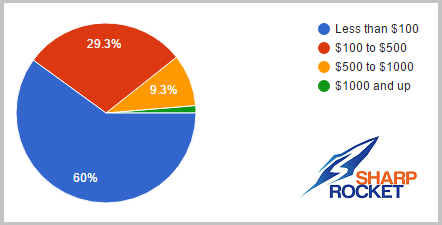
To scale some SEO processes like link audit, PBN owners definitely need SEO tools to help them with their work.
Sixty-percent (60%) of respondents invest less than $100 per month for SEO tool subscription. Others (twenty-nine percent) have $100 to $500 investment on search marketing products which will add to the total cost of their investment for private blog networks.
How many months do you see results in rankings to your money website(s) using PBN?
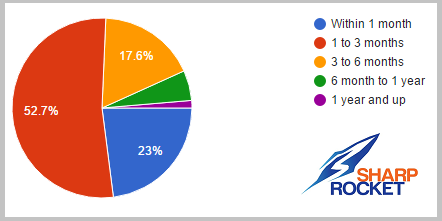
The real deal here is how many months they see search ranking results from their efforts. Fifty-two percent of respondents confidently say that they see immediate results within 1 to 3 months of doing SEO activities.
Let’s do the math both for those who own 3 websites and for those who have 50 websites.
Total cost of 3-site PBN network for three month period (though three sites alone couldn’t be considered as private blog network by some SEOs in grey/black-hat industry) is $525 (sum of $300 on website setup cost (3 month period) and $225 on outsourced content creation - 3 month period).
I doubt if they’re getting results from three websites alone.
The total cost of 50-site PBN network is $12,500, the sum of $5000 on website setup cost and $7500 on outsourced content creation (3 month period).
Do you monetize your PBN network? How much do you earn every month?
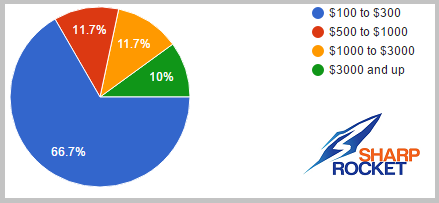
Aside from getting returns on investment from using private blog networks for their money websites, most, if not all, PBNs get returns from monetizing their own PBN networks. A large portion (66.7%) earns $100 to $300 per month. Others get $500 to $1000 and $1000 to $3000 every month from their PBN network monetization. I assume the latter two have more PBN sites than the former.
Different Ways to Invest $4000 a month ($12,500 for 3 months) Into SEO
1. Content creation
Content-based SEO strategies, especially if it is heavily invested in evergreen content can stand the test of time, and you’ll see initial and long-term results from this kind of work – increase in conversions, lead generation, so on and so forth. You can learn how to be more practical with content creation with this content writing post.
2. High quality backlinks
If you seriously want to focus on acquiring real backlinks that have growing traffic and can be placed editorially on highly relevant sites through guest blogging, targeted outreach and other link building strategies, you can invest that same amount $4000 a month on hiring one or two link building companies or hire a team of link prospects and outreach specialists to do the work for you ($4000 can hire 10 Filipino virtual assistants already). Automate it with proper link building sessions/trainings and management.
Further Reading:
Now it’s Your Turn…
If you are getting a return on investment using PBN network, then good for you. Take risk and let your clients know about it.
I know this is a controversial topic.
Do you have any questions about private blog networks? I’m not an expert on it (I don’t have one), but will ask other SEOs to come by and answer the questions for you.
Or maybe you have any insights or thoughts to add?
Either way, leave a quick comment below.
I'll be more than happy to reply to comments and answer questions.
Ahrefs Review: 9 Backlink Research Tactics (2017 Edition)
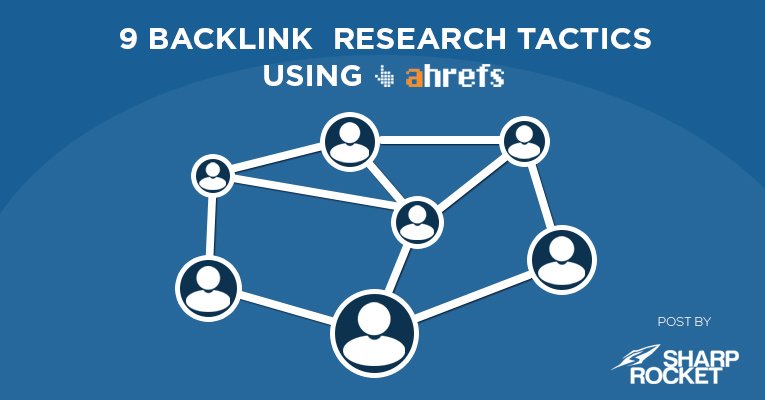
Backlink research is the most difficult part in link building.
Yes, you heard it right.
If you can’t find tons of link opportunities and qualify them based on your campaign’s metrics, you wouldn’t have backlinks.
Trust me.
The most successful link builders are the ones who are very good at finding backlinks.
In this post, I’ll walk you through how to research for backlink sources by using just one link building tool that I’ve been tested and been helpful for my entire SEO career.
Don’t get me wrong, I’m not selling anything (not an affiliate of this web product). In fact, I have some bonus resources for you. Tip: I’m opening my second giveaway today.
[yellowbox][cp_modal id="cp_id_ceb23"]Cool bonus: Download a free PDF version of this guide and get a chance to win a 1 year Standard subscription of Ahrefs[/cp_modal] .[/yellowbox]
Let’s get started.
Ahrefs has been my true friend in finding backlinks opportunities that wouldn’t just come through a normal Google search.
Here are 9 backlink research tactics to build a giant list of thousand link opportunities.
1. BUILD RELATIONSHIPS WITH NEW LINKERS
It’s easy to start a link building campaign and go directly find new ones in your way.
However, you miss out knowing about existing linkers to your website who are actually waiting to be engaged with your brand.
The question that pops up is, why would I waste time building relationships with someone who already linked to us?
The answer:
Recurring backlinks.
Getting backlinks from websites that already linked to you is a good signal for search engines that your site is a trusted source of good web information.
It’s a big advantage on your part simply because every time you publish new content on your blog, you’ll have existing linkeraties waiting to reference your post in their future content pieces.
That’s a less costly way than manually finding new link opportunities and cold reaching out to them.
ACTION ITEM:
Use the Alerts feature of Ahrefs.
Click into Alerts - Add Alert (orange button placed at the right).
![]()
![]()
Enter your domain URL.
Mode should be on a domain level.
Choose “New Backlinks” as your Scope since you only want alerts for new backlinks.
Enter your email to which alerts will be sent to.
Then set frequency either daily or weekly depending on how many times you’d like to receive email alerts. I recommend you choose daily alerts, so you can reach out to that new linker right after you received an alert for a new backlink.
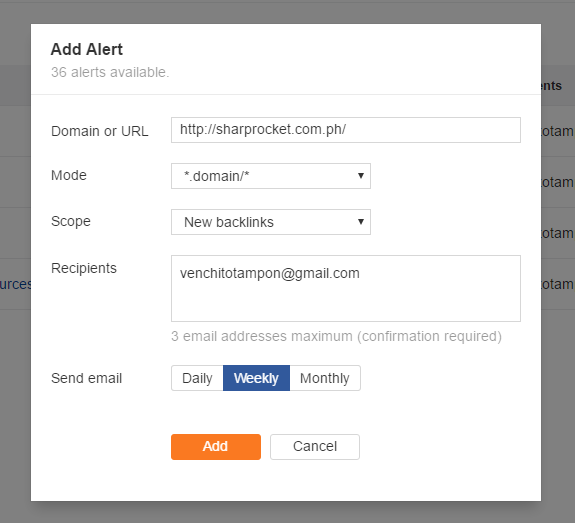
2. GET ALERTS FOR COMPETITORS' NEW LINKERS
Linker outreach is a continuous process.
If content is excellent, it’ll earn organic backlinks over time.
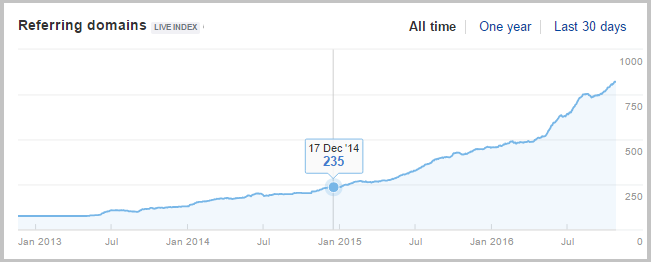
But what if?
You have just created content asset but don’t get any attraction at all.
What you need to do is look at your other publishers’ similar content and reverse engineer their newly earned backlinks.
The advantage here is that linkers of your content competitors are more receptive to initial pitches than those whose content has been published years or months ago.
Publishers who have just posted their articles are still looking for additional resources/references to add to their own content, which makes it more comprehensive.
Here’s good news for you:
You can semi-automate this process using our tool for today.
ACTION ITEM:
You can create alerts to receive an email if a backlink is built/earned by that similar content piece.
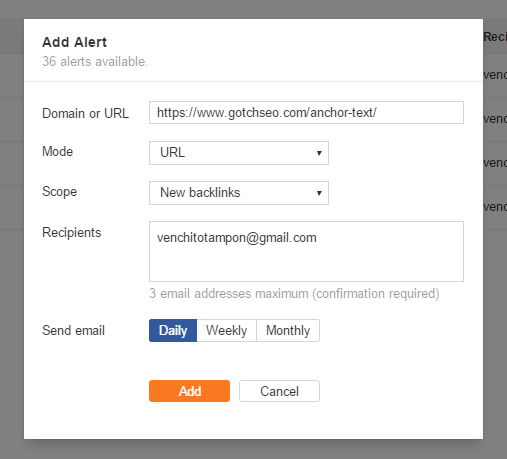
Go to Ahrefs Alerts – Backlinks
Click the “add alert” button at the right.
Enter the URL of your content competitor’s content
Choose URL as your mode.
Enter your email for Recipients.
Click daily or weekly depending on your frequency preference.
Click add.
3. RECLAIM BROKEN LINKS
You lose backlinks.
This happens, whether you like it or not.
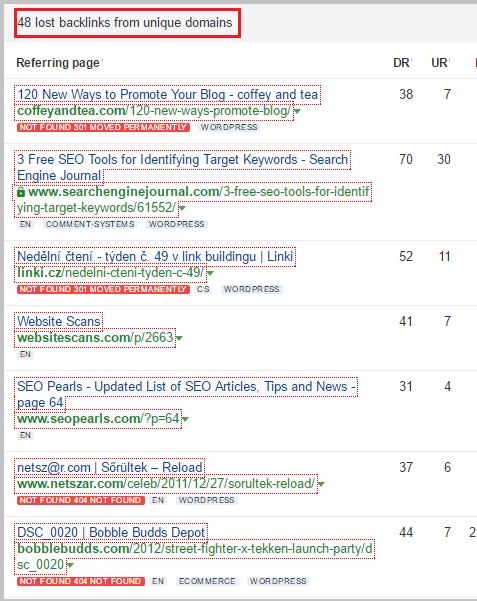
Whether a webmaster deletes a page linking to your site and/or haven’t redirected a non-existing page to a new one, you loss a backlink.
It could also be that you have a 404 page and you’re not aware that it earned/built backlinks in the past.
You can’t redirect because there’s no new similar page or simply just forgot redirection.
You can actually reclaim those broken backlinks, reach out to those past linkers and let them add a link to your other relevant page.
ACTION ITEM:
Enter your domain URL in the Dashboard or Site Explorer then click Explore.

See Backlinks section then click Broken. It will direct you into the list of broken links and your linking pages in the Anchor and backlink column.
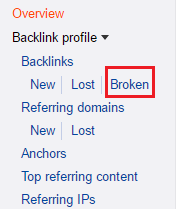
You have two options here:
- Redirect that broken page to a new but highly relevant page.
- Reach out to the webmaster and ask if he can change the link to another similar page of yours or he can simply add another relevant topic page.
4. CHECK LINKABLE CONTENT FOR BROKEN BACKLINKS
Broken link building has become popular for two reasons:
It adds value to the webmaster fixing his resource page for online users.
You get a backlink pointing to your own page.
If you want to scale broken link building, you need a tool to check if there are any broken links found on the page.
That can be your value proposition when reaching out to the webmaster, saying I found a broken resource on your page, would you want to fix it?
ACTION ITEM:
Plug in the URL of the content and choose URL in the drop down menu, then click “Explore”.

Go to Outgoing Links section and click Broken links.
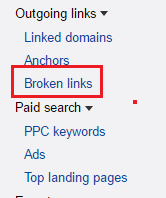
If there are no results, that means there are no broken links on the page. Take note I found it useful in some cases, so I use LinkMiner instead.
5. REVERSE ENGINEER TOP CONTENT
I’ve seen most content marketers have this common process of finding similar content to reach out to for links.

This simple process is mostly time-consuming.
You can actually semi-automate this entire process by using Ahrefs.
ACTION ITEM:
Go to Content Explorer, type in your target keyword or niche topic, then click “Explore”.

Recommended options:
Publish: it should be all time.
Language: I prefer English, if you’re looking for English language sites.
Highlight unlinked domains: click this button and enter your domain to highlight pages that haven’t linked to your webpage.
Relevance: Sort it by traffic, so you can see first high-traffic websites.
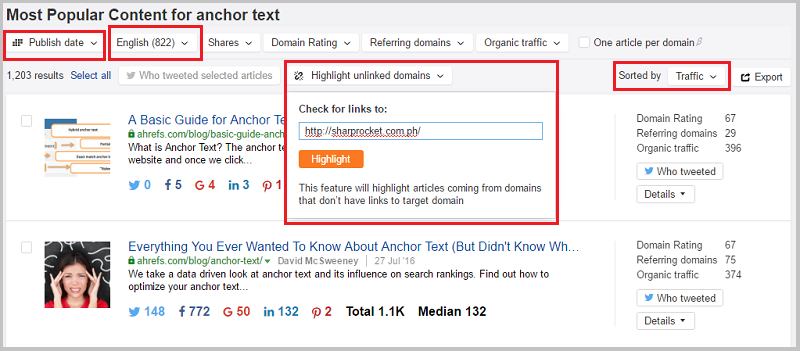
6. FIND BLOG AUTHOR OPPORTUNITIES
Using Google searches to find guest blogging or content distribution opportunities would still require filtering using metrics you prefer (DA, SEMRush traffic, TF, CF, etc..)
If you do searches for “guest post by” “author’s name” or “written by” “author’s name” plus any other similar terms, Google will give you results of different types and not all of them are entirely guest posts, some could be “business profiles”, citations, so on and so forth.
Ahrefs has its advanced option of seeking for industry blogs that you can reach out to for content placement.
ACTION ITEM:
Go to Content Explorer.
![]()
Type in author:name
Replace name with a popular guest blogger or an industry content contributor.

Sort websites by Traffic, if you’re aiming to build exposure to websites that already market themselves (with good traffic in other words).
This is optional. Click Highlight unlinked domains, then add your domain to only see websites that you haven’t acquired backlinks yet.
7. EXPAND YOUR LINK LIST WITH AUTOMATED "AROUND"
Glen Allsopp shared this “around” search operator in his post about advanced link building, which all link builders can use to increase their link prospect rate.
Quite interesting because I’ve been building backlinks for years, but haven’t discovered that yet.
Anyway, the idea with using around search operator is to find link prospects that includes two words that are in close proximity but are not together. For example, submit and "guest post" in this search query are not together but both are in close proximity not more than 4 words apart.
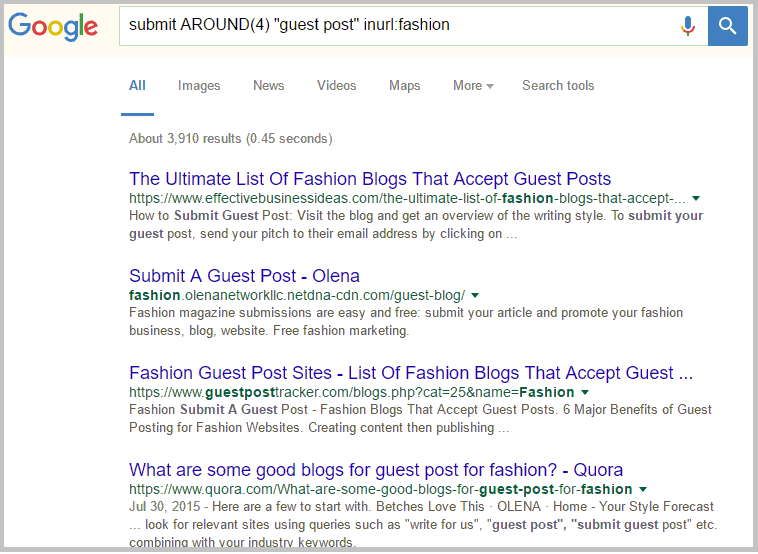
Ahrefs allows you to do this.
ACTION ITEM:
Go to Content Explorer.
Type in your target keywords or keyphrase.
For example, if you are looking for branded mention opportunities in your industry, you can try using "BRAND" "keyword"~5. For example, "ahrefs" "link building"~5. Then choose “Title” in the drop down menu.
This gives you results that have the “keyword “health” and with words “submit article” that are 4 words apart from each other.
8. STRATEGIC COMPETITOR LINK ANALYSIS USING LINK INTERSECT
I’ve seen most competitor link analysis fail for two reasons:
One is that link builders don’t know how to identify the right competitors. They only like to dig into links pointing to top sites like Forbes and Huffingting Post, then analyze how those links were built. Sites like these are authority in all industries and that’s enough for them to rank and be linked to heavily by publishers.
They are not your competitors, if you are still starting to build your own brand, find those who are ranking on similar content but haven’t much gained higher authority rate. Know if both of you are targeting the same audience in the same buyer’s journey. Look at their SEMRush traffic and total domain referring domains.
Know if it’s realistic to compete with them.
Second reason why competitor link analysis fail is because some think that creating a list of backlink opportunities of all competitors is the starting and end points of the process.
There’s a reason why it is called link analysis, because obviously you want to analyze how those links were built and/or earned. What content type is linkable in nature in your industry? How do the audience resonated with the piece and why did it go viral, if it did?
These are just a few questions you should ask yourself before you get your hands dirty with link building.
ACTION ITEM:
Once you’ve identified who your real competitors are.
Go to Ahrefs, click into Tools and choose “Link Intersect” in the drop down menu.
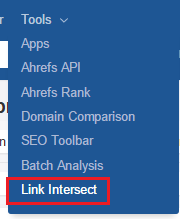
Include all your competitors’ domains in blank sections under “Show me who is linking to all of the below targets”. You can use the plus button if you have more than three competitors.
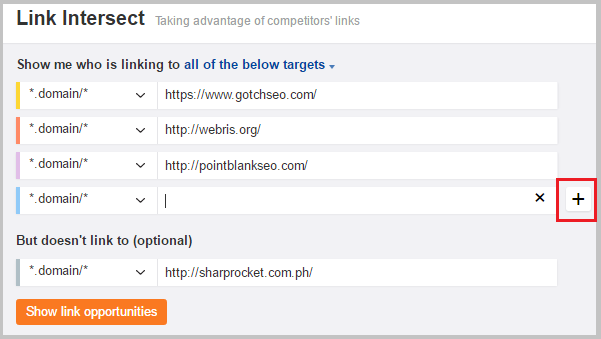
Then click “Show link opportunities” button.
This is what results look like.
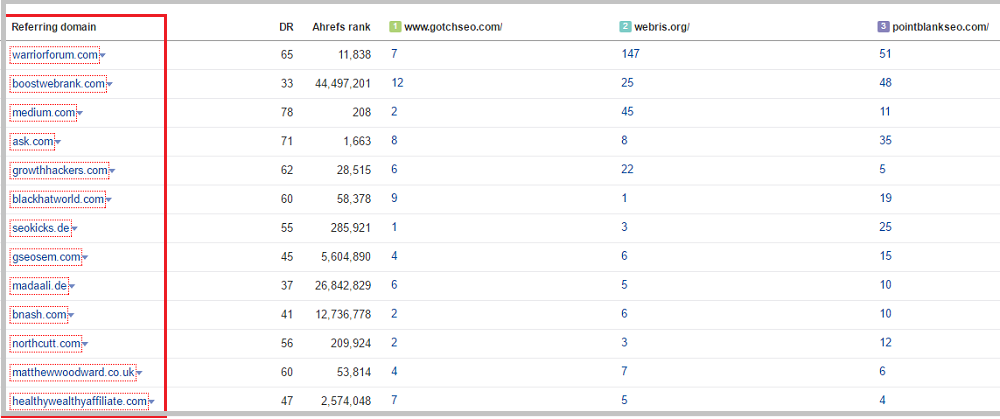
I can go forward to acquire same links and mentions from top websites that all linked to my competitors. For example, I can then create a WarriorForum profile and start answering questions there and posting relevant threads with referential links to my relevant content.
9. USE BATCH ANALYSIS FOR SCALABILITY
What I simply like about Ahrefs is its ability to scale processes. If you’re working in an agency, you know it is vital to get all things done as soon as possible to bring in more results for each client’s link building campaign that you handle.
The batch analysis feature of Ahrefs can help you generate multiple backlink repots at once by simply entering a list of domains or URLs you’d like to reverse engineer pointing backlinks to.

If you are trying to see how your website performs in terms of link acquisition compared to your competitor sites, you can use batch analysis to quickly see the gap between your site’s backlink performance and from your competitors.
You can get some insights on different things, such as:
- Number of referring domains each competitor have acquired
- Types of links they’re getting (do they have some .gov. or .edu backlinks?)
- Do they have a diverse backlink profile?
If you are executing broken link building at scale, batch link analysis is very useful in identifying which broken page can be recreated or upgraded to another version of the content.
By inserting all URLs of broken pages you’ve found in your list and sorting them from highest to lowest referring domains, you’ll then see which broken page has acquired the highest number of backlinks.
See if that page is feasible to be recreated, use all resources to get it published on your site and reach out to those who have linked to the piece.
Bring this Ahrefs Review guide anywhere...
[cp_modal id="cp_id_ceb23"]
 [/cp_modal]
[/cp_modal]
Now It’s Your Turn…
How do you use Ahrefs for your daily or weekly link building use?
Or maybe you have a question on how to implement any of the backlink research tactics in our above list?
Either way, leave a comment quick below.
I'll be more than happy to reply to comments and answer questions.
So if you have a question, insight or new tactic, leave a comment right now.
How to Get Editorial Links to Your Website
Editorial links are the most powerful type of links given that it signals Google that the brand being linked to is a trusted resource/reference (either it is targeting the homepage of the site or its inner pages/contents).

There are three primary elements that can intensify your chances of getting in-content links for your website:
- Strong direct relationships with bloggers and content publishers in the industry.
- Content seen has a uniquely useful information and unexpected hook, which edges the content piece over pages hosted on competitors’ sites.
- The brand has a large influence over its community through its published high quality content and coverage/mentions from popular news/media outlets – which makes it easy for the brand to be remembered by top media/content publishers when writing posts for their blogs/sites.
Acquiring contextual links editorially from content creators requires extensive amount of effort and time especially for websites who’re still starting out to build their influence and authority from scratch.
Tactics that aim to consistently attract editorial links to your content/site would usually take 4 to 6 weeks or even months for brand new websites. Though they’re all time-consuming, these tactics that I’ll be sharing to you are not impossible to do.
1. Trust marketing
Without trust, it is almost impossible to earn and editorial links, simply because content creators are keen to choosing credible sources/pages that they’d like to mention in their future works.
Trust marketing brings edges to new brands without enough to content to compete in the industry. With proper engagement and content development, new websites can now attract in-content backlinks from industry-related publishers with trust as its main component of link attraction.
Personalize your brand by choosing one team member (prefer it to be your site’s content creator) to spend most of his/her time producing high quality content pieces that’ll be published inside and outside of your company website.

Get him/her engage in niche-specific community platforms like forums and Q&A sites by providing direct and useful answers to topical questions in your industry. Spend at least hour every week for community engagement, because you’ll learn great insights from this activity – i.e. understanding the deepest needs of your target users, which you can use to create a user-generated content that targets a specific group of users (mostly potential linkers).
Wil Reynolds shared a very interesting presentation on conversion-oriented forum link building. He specifically discussed one ecommerce client who generated $11,000 revenue from a simple one-hour a week forum engagement.
Trust marketing can also yield contextual links from brands (with pre-existed relationships) through interviewing one of your brand publishers in their own blogs.
2. Invest in scholarships programs
For brands with big marketing budgets, setting up a scholarship program and publishing a page on it is one of the effective ways to earn reputable backlinks nowadays. Educational institution sites and government pages tend to link to scholarship programs that provides intrinsic value to their target visitors and users.
Though most of the time there’s only link that can be built from a single domain using this link acquisition technique (scholarship link building), still the relevant traffic and assisted conversion it can bring to the website are very much promising for the business.
This client of mine in the education niche acquired 62 .edu links through its scholarship program – which adds hundreds of referral traffic to his website and helps the site rank for relevant industry keywords.
You can request for a profile section from your target linker to explain more details about your program. This will entice users from other sites to visit your scholarship page and contact you for future partnership programs (this might get you additional editorial links from potential linkers).
3. Do secondary-competitor reverse engineering
Competitor backlink building is not just creating a huge list of backlinks earned/built by competitors but also understanding the relationships of linking pages and the page/site being linked to.
Reverse engineering (other term for competitor backlink building) can provide you an easy way to earn your first set of links (without need to prospect for targets from scratch).
The most common reverse engineering method is finding websites that currently rank in search results for your target keywords (either these keywords are commercial, transactional or blog-related).
Though this approach is pretty much powerful for local-based businesses, adding a few more ways to improve your reverse engineering process is definitely worth to try out in order to lessen footprints caused by building links also gained by your competitors.
Target links seen in resource pages as your secondary competitors when doing reverse engineering activity.
You can build a larger list of link prospects using this approach given that most of the time, links in those resource pages are not visible in search results.
Use Ahrefs, OSE or other third-party link analysis tools to track existing links of those secondary competitors. You can apply any of the following link tactics to acquire those editorial links:
- Pitch webmasters who have resource pages with broken links in them and ask if they’ll be interested to replace their defunct links with hyperlinks pointing to your website and to your other suggested resources (choose non-competitor links as your other suggested links, so as not to help your competitors gain the same amount of links your brand is getting).
- Contribute on industry blogs that have high search share and engagement level to build recurring links to your content(s) every week/month. Ask their content managers if you can apply to become their regular content contributors.
- Understand how your primary competitors (prospected from search results) and secondary competitors (other links in your target resource pages) acquired their current editorial links. They may have used any of these tactics: moving man method, press pitching or social link building.
Once you’ve created a giant list of link prospects through reverse engineering, you can now create a link strategy/plan to build those in-content links.
4. Profile editorial links from content contributor/speaking opportunities
A brand ambassador with a superb expertise in an industry often receives speaking and content contribution opportunities because he is recognized as one of the top influencers through his valuable contribution on top industry blogs and his non-profit social and community engagement.
Target corporate speaking and authority blogs for speaking and content contribution opportunities since most of the time, they allow individual profile pages for each of their contributors/speakers which’ll make it easy for target participants and readers to know more about their authors/speakers.
Other opportunities to earn editorial links from profile pages include:
- Sponsorship and exhibit programs for local and international events, which allows sponsors to expose their brand to a wide variety of potential customers/clients both offline and online.
- Local or international volunteerism on popular events with an opportunity to be mentioned in a volunteers’ list (specific brands) in a separate page of their website (there are cases that they also publish profile pages for brands who volunteered to the event).
Invest in networking with other brands in your industry (should be non-competitors) to earn unexpected in-content links from voluntary events in industry-related events and seminars.
5. Quoted insights
In today’s digital marketing, content creation is now a requirement for every brand who wants to build and earn non-manipulative links from reputable websites/blogs.
When producing high quality content, it is imperative to add unique insights/quotes coming from your brand ambassadors and content creators in order to make your content comprehensive to read or to consume.
This approach allows you to earn voluntary-given backlinks from bloggers and researchers who want to use your content creator’s quotes/insights contained in your content.
Make a consistent effort to produce high quality content on your website that have information that is found nowhere else (this element is commonly called unexpected hook).
6. Optimize your pages for natural language optimization type
Natural language patent was released last November as a method for Google to extract data from an authority page listed in search results in order to provide a direct answer to a specific search query.
This allows many authority pages to be seen by new search users as a recommended answer for a specific questions/query.
Add information to your page that is straightforward and that suits a specific search query or keyword phrase (e.g. symptoms of diabetes).
You can link to your page from other related internal pages in order for your new visitors to see your main target page. This will also help the page to increase its page authority and rank for that specific query.
This approach may help your page be seen by researchers or bloggers in that specific area, which will eventually help your content to earn editorial links from their blogs/sites.
Here are other resources that you can check out for more information on this topic:
- Direct Answers: Extracting Text From Pages Citations
- Direct Answers: How Answers Are Extracted From Web Pages
- Direct Answers – Using Query Intent Templates To Identify Answers
- Direct Answers – Taken From Authority Websites
- Direct Answers – Natural Language Search Results For Intent Queries
More Resource: How To Promote Your Latest Blog Post Like A Boss
25 Creative Content Promotion Strategies
If there is one thing you shouldn't forget about content marketing, it is implementing a solid and creative strategy to promote your content assets to your target audience.
A strategic content promotion plan would help you in so many branding activities, such as:
- Building communities (sub-groups of your target audience) that are exposed to your brand, which can help your future content get social shares in its first days after launch.
- Increasing the probability that bloggers in your space would link to your content (especially if your content is worth sharing to their readers).
- Engaging with popular media outlets in your local and niche vertical who would be interested to cover news or stories about your brand, which would be made easy if they’re attracted to new information or ideas from your content.
- Generating leads/sales through referral links from popular blogs/sites and connections built with influencers during the process of promoting your content.
If you already decided to invest your time and effort in showing your content to your target audience (especially those who still don’t know your asset), then you can follow at least ten of the content promotion strategies I listed below.
1. Multiple-effect email outreach
Content promotion through outreach is done in a one to one person basis (unless you’re doing an email blast for your campaign).
If you send 100 emails and you get a 10% click through rate, it means that you have an additional 10 visitors on your site (assuming we exclude those people who were referred by your recipients to visit your site as well).
The chances of getting more visitors who will likely to share your content depend on the number of recipients and emails you send to them. The larger your list of recipients, the more new visitors you should expect to see in your Google Analytics account.
You can make this 1-to-1 email outreach work more effective by adding a few texts to your email template.
You can actually increase the chances of getting a few more visitors from a single email using this simple approach.
How?
Step 1: Find generic branded emails in your list of prospects. Examples of the types of emails you should look at are:
Step 2: Add these simple lines to your email template (beginning and end of your email).
I noticed that your team tweeted a [topic] post on [Site Name].
Happy to hear a feedback from your team.
Step 3: Add this subject line to your email.
A post that your team might want to see
Step 3: Click the send button (or schedule your email if you are used to it).
Because you allow your email to be read by a team, you have chances of getting more shares from each person in that group (once they passed it on to one another). Additional visitors to your website and followers would be possible if your content captures their interests.
2. Invest in building interview opportunities
Interviews are open doors to show off your expertise and improve your site discovery by allowing people to visit your best pages/content (which will help them decide if they want to follow your brand in a regular basis).
How to open interview opportunities?
Step 1: Create an interview page.
You don’t need a highly skilled graphic designer to create a well-designed interview page for your website.
You can do it by yourself. Here is an example of how a high quality interview page looks like:
An interview page should consist of the following:
- Your expertise or topics you’d like to discuss about (you can use this as your introductory sentence)
- Interview requirements including audience type and the topic of the interview (number of email list is optional).
- Contact form
Step 2: Make this page visible to your visitors.
There are a few things you can do to add more visibility to your interview page:
- Add a menu linking to your interview page.
- Link to it from your about us
- Design a simple advertisement and make it sticky in the sidebar of your website (you can use Q2W3Fixed Plugin).
Step 3: Promote your interview page.
Share your page in your social profiles.
You can also link to your interview page from your newsletter, once in a while to boost its visibility.
As you consistently produce more high quality content on your blog, your chances of getting interview opportunities are higher.
Few more tips to maximize your interviews:
- Build second-tier links to pages that are already linking to your site through referencing them from your interviews (add a descriptive call to action when linking to those pages to entice clicks and shares).
- Use your interviews to capture subscribers from blogs where interviews are hosted.
- Promote your contributions through linking to them from your about us page (this will add some trust and build stronger relationships with the interviewers, allowing you to get some more interviews).
 3. Guest blogging post benefits
3. Guest blogging post benefits
Guest blogging has a lot of benefits even after you got a link and shares from the content distributed site.
You can promote your content to people who've shared your recent guest post and get them share your newest content as well. Given that they already know your brand through the caliber of your content, it’s easy to entice them to share your content (assuming you exceeded their expectations as readers).
How to do it?
Step 1: Identify social shares of your recent guest post using Topsy. Grab the URL of your guest post and paste it on the search box. Then click the search button.
Step 2: Check if those social sharers have their own websites or blogs. If they have, include them in your Twitter spreadsheet.
Step 3: Find their email addresses using any of the following tools.
- Twitter Google search (inurl:twitter.com/venchito14 “email” OR “at” “dot”)
- Whois
- Basic email placement pages (about us, contact us, get in touch, etc..)
- Rapportive in Gmail
Step 4: Send them outreach emails using the template below.
Hi [Name],
I noticed that you shared [topic post] on [Shared which post]. I appreciate your social sharing a lot.
Just wondering if you’d like to see my latest 4000-word ultimate guide about [topic].
Please let me know if you want to check it out.
Regards,
[Your Name]
Why this outreach works?
- You thank the person who shared your post.
- You make your description strategic and short (e. 4000-word ultimate guide).
- Ask for feedback (indirect enticement of response)
4. Send exclusive content to twitter list (list of followers who retweet/favorite your posts)
Your brand needs a community whether you’re a one man team or handling hundreds of team members.
Building a solid community these days is easy with social media marketing.
If you’re actively sharing posts on Twitter or at least engaging your followers through retweet and favorite activities, then you should start creating Twitter lists to leverage your engagement and increase social following even more.
You won’t just create a list and leave things behind.
You should think of an exclusive content that you’ll provide to them to strengthen connections and attract more social followers through their behaviors of sharing your content to their followers.
Here is a simple step by step guide to apply this content promotion method:
Step 1: Find all social followers who mentioned you in their tweets. Most of the time, these are your followers who also shared your content before.
You can use SnapBird to find them.
Step 2: Create a twitter list. Include all followers whom you think you can share your content to.
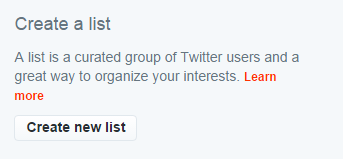 Step 3: Ask or find their email addresses. You have two options: send them personal messages and ask if they can give you their email addresses or manually search their contacts using email finder tools mentioned earlier.
Step 3: Ask or find their email addresses. You have two options: send them personal messages and ask if they can give you their email addresses or manually search their contacts using email finder tools mentioned earlier.
Step 4: Send them exclusive content via email. You can use this email template below:
Hi [Name],
I’m [Name], [Position] at [Company Name]. I saw that you tweeted my post on [Blog Name]. I appreciate it a lot.
I just want to ask if you’d been interested to check out an ultimate guide for [topic]. This is something that I’ve been working on for the past 3 months and would only want to share exclusively to my active followers.
Please let me know if you’re interested.
Happy tweeting!
Regards,
[Your Name]
5. Schedule your reply emails appropriately
If you've been doing outreach for content promotion for quite a long time now, you know that one of the important factors that affects email open rates is the timing of outreach.
If you schedule your initial outreach email at the best time your recipients would likely to open it, make sure that you also do the same thing with your reply emails.
The reason why conversations were stopped is that the second to third reply emails were received by prospects during non-peak hours. If you can schedule your reply email at the time your prospect replies to you in your initial outreach, you'll get much success from it.
To schedule your follow up emails, you can use Right Inbox.
Step 1: Open your Gmail account, then click the Compose button.
Step 2: Write your message and subject line then add your recipient’s email address.
Step 3: Schedule your email at the time your prospect replies to your initial outreach.
Step 4: Send your email.
Further reading
6. Use your preferred anchor texts when describing your content
The old school way of letting your link prospect know about which anchor text you prefer to be used (in linking to your content) is to directly tell him the anchor text (e.g. Would you please link to me using this anchor text: payday loans).
That link building practice won’t get much success today as it will make your email look like spam.
One way to actually make this linking practice still work is to add some phrases to your email to describe the content that you want to promote.
How to do it?
Step 1: Edit your email template. Instead of only using these texts– if you want to check out my post, you can click on this link, you can actually add some descriptive phrase to your email.
If you want to check out my broken link building guide, you can check out this link: (link here).
Step 2: Add your subject line and your recipient’s email address.
Step 3: Click the send button.
7. Use popular hashtags in your tweets
Hashtags add more social visibility to your tweet, making it easy for your tweets to be seen by active social participants other than your followers.
If you will add popular and relevant hashtags to your tweets, you will have chances of increasing your tweets' social discovery.
How to do it?
Step 1: Go to BrandMentions' Hashtag Tracker. Scroll down the page and look at the popular hashtags section.
Step 2: Use relevant hashtags to your tweets. If you are in the business niche, you can regularly use the hashtag “sales".
Step 3: Do it religiously.
8. Reduce link noise ratio by estimating the number of external links
Obtaining a link from a resource page is tough these days as there are a lot of success factors that will make your broken and resource page link building works, including:
- Relevancy and utility of the content suggested adding to the page.
- Real purpose of the page listing all the links and resources in it.
Another success factor to consider is the number of external links in a resource page.
If there are too many listed links, the probability of earning the link is low and the value you’ll get from it (if in case, you earn that link) will be diminished by the dissemination of page authority to several external linking pages (the higher the number of external links, the lower link juice you’ll get).
The main point is to find a relevant resource page that have a fair amount of external links.
How to identify the number of external links in a resource page
Step 1: Plug in the URL of the resource page to Ahrefs.
Step 2: Go to Outgoing links tab – Linked Domains.
Step 3: Look at the number of results. If it is more than 100, then find another resource page to prospect on.
The reason why you need to consider the number of external links is to increase the probability that you’ll going to get the link once you start reaching out to the target linker. The higher the number of external links in a resource page, the lower the chances of earning your desired backlink.
9. Use manage subscriptions link instead of unsubscribe link in your newsletter
When people are not satisfied with your newsletter content (email), they usually want to find the unsubscribe link to get rid immediately of all your future promotional emails.
This will obviously decrease the number of your subscribers in your email list.
But you can avoid people to unsubscribe to your blog but at the same time allowing them to do it if they decided to do so.
How?
Step 1: Go to your email marketing tool settings (for this example, I use Mailchimp).
Step 2: Go to settings (for Mailchimp: Campaigns – Design). Then select a template.
Step 3: Edit the footer section by changing the unsubscribe text to manage subscription.
Step 4: Click Save & Close button.
10. Build links from non-English blogs
If you limit your link building strategy to relevant niche and local blogs, you will be boxed with link opportunities surrounding your space only.
But if you go a step further and look for non-English blogs that can translate your content to other languages, you’ll find much success with it in terms of building high quality backlinks.
How to do it?
Step 1: Use your descriptive keywords as your search queries and add the site search operator to it (e.g. online marketing blog site:.fr).
Step 2: Populate your list by prospecting more related non-English blogs. Use the related search operator as your search query.
Step 3: Reach out to your list of non-English blog owners and ask if they’d be interested to translate your content to other languages and publish it on their blogs. You can use this email template below:
Hi [Name],
I’m [Name], [Position] at [Company Name]. Heads-up to your recent post about [topic]. Thanks for sharing it.
By the way, I’d like to share my recent link building guide on [topic]. I’m wondering if you’d be interested to translate it to [language].
Please let me know your feedback.
Thank you,
[Your Name]
11. Interlink relevant client posts
If you’re working on several link development campaigns that are all in the same industry, you can maximize every post/page you’re getting links for each of those campaign.
However, you have to be careful with it because you don’t want Google to see some kind of footprint in your campaigns. Make sure you include your client’s domain to your other client’s target page when they are only relevant to each other.
Here’s how to do it.
Step 1: Find a topic that will allow you to include two separate domains of your clients in a single blog post (assuming in this example it is a guest contributed article).
There’s no tool that you can use here. Use your brain. Be creative and target a non-very specific topic as much as possible.
Step 2: Write the post.
Here are a few things that you can consider when you want to apply this approach:
- Use list post as your content format to make it easier for two domains to be included in that single post (just make sure both domains have the same offerings – e.g. both have Wordpress plugins).
- Use one domain as your example (in case you want a case study type of post) and just link to the content page or category page of your other client’s domain.
- Use one domain’s image (link to the homepage URL/post URL if possible, not to the attachment URL) as your featured or secondary image, then just contextually link to your other client’s domain from the same blog post.
- If there’s no chance to include both domains, don’t try to do it (always remember that one post must have one message/information to discuss about).
Step 3: Publish and promote the post.
If you’re handling multiple clients (4 or more) all in the same industry, you can maximize all your linking opportunities by following this content promotion strategy.
Even if it is an image linking to a homepage URL of one of your client’s domain, it is still worth it, especially if the page/post is relevant to the domain.
12. Produce regular round-up posts on Google+
If you’re still not leveraging Google+ as one of your content promotion platforms for your brand, then you’re missing a lot of marketing opportunities.
Posting weekly roundups on your Google+ profile can help you in so many ways, such as:
- Increasing your Google+ engaged followers.
- Build connections with Google+ influencers particularly those authors of articles you’ve mentioned in your round-ups.
- Amplify your content through link inclusion in the round-up, engagement (+1s, share, etc..) and sharing activities from Google+ influencers in your space.
Here’s how you can effectively apply this technique to your content promotion plan.
Step 1: Create a list of weekly popular content (slide decks, articles, guides, courses, etc..) in your industry. You can quickly find them on your niche community site (for online marketing niche, you can visit Inbound.org to find daily best articles).
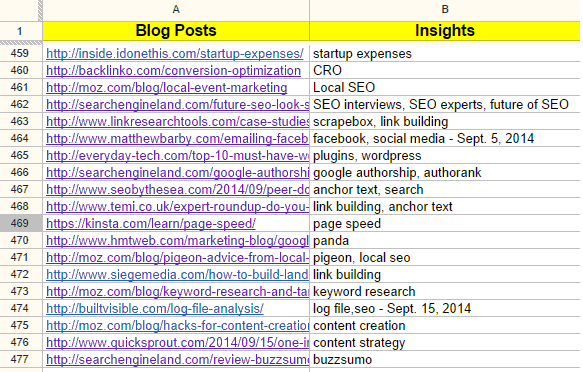
Step 2: Write your Google+ post. You can follow this simple format.
Use categories to classify your list of resources and to add hashtags to your post (which can help increase the post's visibility and popularity).
Write a call-to-action at the end of the post to encourage your social followers to check out your next roundup posts.
Step 3: Promote your Google+ weekly roundup.
To promote your roundups, you can share them to your email subscribers, site visitors (by linking to it from your blogroll links) and on your Twitter profile.
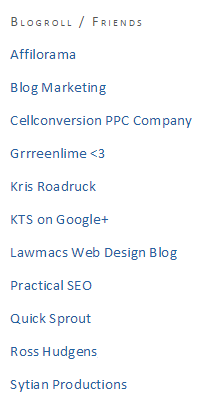
Posting weekly roundups with links pointing to your site’s internal pages is better compared to single posting of your article on Google+. Your roundups could earn more social shares and +1s than your self-promoting posting on that social platform.
13. Increase homepage links with simple email outreach
Choosing between a homepage link and a deep link, when pursuing links, is still a debate today.
In my opinion, both have benefits to your website:
- Building links to your homepage could pass authority and link juice to your sub-pages and posts.
- Deeps links will prove that your other pages/posts aside from your homepage are serving your visitors appropriately.
Let’s move on to building homepage links to your website.
Here's how you can do it.
Step 1: Export all links pointing to your website (whether homepage or deep pages). You can use any of your favorite link building tools (Ahrefs, OSE or Monitor Backlinks).
Step 2: Remove unnecessary columns and only remain columns for page rank (Ahrefs rank), referring page URL, referring page title, number of external links, link URL and link title).
Step 3: Sort by Ahrefs Rank and Domain Rank (highest to lowest).
Step 4: Check out corresponding referring page URLs of non-homepage links in the Link URL tab. (e.g. if you see a www.domain.com/blogpost in the Link URL column, and its corresponding referring page URL is www.referringdomain.com/blogpost1 , then visit the latter URL).
Step 5: Identify if the deep link placed in the referring URL can still be changed to homepage URL. You can consider the following things:
- If contextually placed within the content, check if it makes sense to replace the link with homepage URL, i.e. it will not deteriorate the overall message of that section of the content.
- Identify descriptions to the link (e.g. According to Moz, the large portion [link]). If it mainly describes the content to the site’s inner page, then it could be impossible for content managers to edit the text and link.
Step 6: Reach out to the content manager and ask to change the deep link to homepage link. You can use this email template from Ross Hudgens.
Hey NAME,
Thanks so much for covering our recent article. QUICK CUSTOM RESPONSE TO COVERAGE.
Anyway, I’m reaching out today with a small request – is it possible to link to our homepage, http://WEBSITE.com where you mention BRANDNAME on the post? I think it would add additional value/context to your readers, and of course, would be much appreciated as well.
Thanks so much for considering and if nothing else, consider this email a thanks!
Cheers,
NAME
14. Tag and category-based infographic promotion
Infographic marketing is not a common content-based initiative today. Several brands had already invested into this content creation process because of the value infographic could provide to a certain brand or website (i.e. reach, branding and SEO benefits).
The common outreach practice for infographic promotion is asking the webmaster if he/she is interested to publish the infographic on his blog, share it to his social followers and get the link that the brand deserved.
There’s nothing wrong with that. But if you can add a few tweaks to your outreach email, you can help your infographic earn more shares and natural links from researchers and bloggers.
You can add these lines to your email:
Thank you for allowing us to publish our infographic on your blog. Could we request something? Is there a chance to put some tags on it (tag 1, tag 2, tag 3) and put it under [Site’s Category] to let your visitors find the image easily.
Thank you.
The more your infographic becomes visible on several tags and properly categorized on the hosted blog, the probability of earning more page views is higher.
15. Customize your site’s search box for most commonly used keywords
Optimizing your site search can help your visitors convert to customers (see this ConversionXL post for more information).
Site search optimization is not only good for conversion rate optimization but also for adding visibility to your most important pages (those that already gained popularity and authority in your space).
When people search for specific terms that are visible in your search box, your authority pages (e.g. top blog post) will normally be placed in the top spots of search results and thus, can earn additional shares and links from people who’re digging information from those pages of your website.
Here is a great post on ConversionXL that will walk you through customizing your site’s search box.
16. Build relationships with active members in niche content-upvoting sites
This technique will depend on whether or not your industry has websites where you can submit your post and be upvoted by other users (when found to be of high quality and useful for them).
Examples of these content-upvoting websites are Reddit and Hacker News.
Getting your content to top page for those websites in the category of your choice would need connections with active memebers in order to rank easily in those sites.
You can follow this step by step guide.
Step 1: Search for active members in your niche’s community website.
Step 2: Research on their personal blogs or websites, contact emails and social profiles (simply do a Google search for their names to find those basic details).
Step 3: Reach out to them and build relationships.
17. Monitor resource pages and discover newly founded broken links
If you are using broken link building for your marketing campaign, then this content promotion technique is for you.
Resource pages are not constant in nature. Webmasters and content managers constantly update links pages with new resources and remove any resources that have no content in them (404 pages).
If you already executed an outreach campaign for resource page link opportunities before, then you may want to go back again to your list of link prospects.
What to do?
Step 1: Visit each of the resource page included in your list and check for new broken links (you can use Domain Hunter or Check My Links tool).
Step 2: Update your list with new founded broken links.
Step 3: Reach out again to resource page owners with broken links in their pages.
Pro tip: Take note of newly added content to resource pages and discover pages linking to them. This will help you find more link opportunities for your website.
18. Community-based guest blogging
Guest blogging is not dead. SEOs are still using it in the right way to show their industry expertise and increase popularity for their websites through links acquired from referring domains.
Blogs with built in community are the best places to get links from given that you do not only get some SEO benefits but a ready to engage people that can help promote your content.
How to do it?
Step 1: Go to Reddit and look for the reddit sections that are related to your industry (simple type in your keyword in the search box).
Step 2: Visit the top pages in your reddit niche section.
Step 3: Identify if there’s an opportunity to contribute content to those discovered blogs. Look for guest blogging guidelines or contribution page, or simply reach out to site owners and ask if they are interested for a free content (guest post).
Step 4: Contribute content to those websites.
19. Add print this page button to your page
Online marketers love to add social sharing buttons to their webpages but tend to forget adding print this page button to pages or content that can be used as references for educational purposes.
A few benefits of adding that print button to your page:
- Allows visitors to share your page offline to their colleagues (after printing it on hard copies), which puts more eyeballs to your page
- Entices researchers to understand and learn information from the page, referencing it for their own content works.
Check out these resources to add print page button to your pages:
20. Strategic internal linking
Internal linking helps your non-ranking pages get promoted from pages that already have high page authority and have some domains already linking to them.
If you’re still new in blogging, you won’t get much success with it, but as time goes by, your readers or fans will begin to read more of your pages not just the blog post that they landed on the first time.
And this is where internal linking helps. It attracts people to read more of your content, which will later on translate to links and shares (when these people start to reference your works from their websites or just share it to their social followers).
Here’s how you can do it.
Step 1: Go to your Google Webmaster Tools account – Search Traffic – Search Queries
Step 2: List down all search queries with high impressions and CTR but have low Average position (low average position means that they’re not ranking high in search results).
Step 3: Check what pages on your website are targeting those search queries or keywords. Then include them also in your spreadsheet.
Step 4: Go to Open Site Explorer. Plug in your website into the tool and check the Top Pages section.
Step 5: Link to non-ranking pages (pages that have low average position) from your top pages in OSE. Ensure that linking pages are topically relevant to each other.
21. Entice engagement through Recent Comments plugin
One of the main goals of blogging is to increase page views and time spent by visitors on the site through engaging them in the conversation or comment platform (below each blog post).
You can achieve that goal for your campaign if you can add a recent comment section on your website.
Here is an example of a recent comment section on SEO by the Sea.
How to do it?
Step 1: Install Recent Comments plugin on your blog.
Step 2: Make your community aware that your comment section exist. Share it to your social followers.
Add these simple lines to your status updates.
Hey guys, you can now see recent comments on my blog [attach screenshot]. :) Let’s talk in the comment section.
22. Fix two widgets on your sidebar
Remember the fixed widget plugin?
You will use it again in this content promotion strategy.
The process is very simple. You fix two widgets in your sidebar to increase your chances of achieving any of your two main brand-related goals.
For instance, if your goals are subscription growth and social following boost, then you may want to fix your email opt-in form and social profiles widgets.
How?
Step 1: Login to your Wordpress account. Go to Appearance – Widgets. (Make sure you install Q2W3 plugin)
Step 2: Click Primary or Secondary sidebar.
Step 3: Click on the widgets that you want to fix on your website. Then check the Fixed Widget check box.
Because you have two widgets to display on your website (which is very visible even if your visitor scrolls down to the bottom of the page), you have high probability that the visitor will click any of the two options: subscribe to your newsletter or click on your image pointing to your resource page (or content).
 23. Regular content contribution for blogs with huge email lists
23. Regular content contribution for blogs with huge email lists
Bloggers are now revealing their email list numbers on their blogs (see examples below) to help them built trust to their target audience and capture their emails through the opt in forms.
If you’re planning to do regular content contribution on popular blogs, then email list number should be one of your deciding factor when identifying if a blog is worth submitting your guest posts to.
Further Reading: Free Responsive Email Templates
24. Use branded photos for content promotion efforts
Visuals or images help users to depict in their minds the information they consumed from your content. It also helps them understand easily the message being presented in the article or page.
You can actually use images (particularly branded images) to get more exposure for your content (image content promotion).
Take a look at this simple image below. Did you know that it has been used 700+ times on the web?
Images can give you links that are properly attributed to your domain. With that benefit, it can help you increase your domain authority as well as the authority of the page being linked to (where the image is included).
Here is a step by step process on how to maximize images for link building and content promotion purposes:
Step 1: Find a non-licensed image to edit as your featured post image. Do a Google search for a term/phrase and click Images.
Click on Search Tools – Usage Rights – Labeled for reuse with Modification.
Step 2: Save the image of your choice and edit it using image editing tools like Pixlr and Canva.
Step 3: Include the image to your article, whether it is for your blog or guest blogging.
Step 4: Track non-attributed images using Tineye. Simply upload your image to see image results.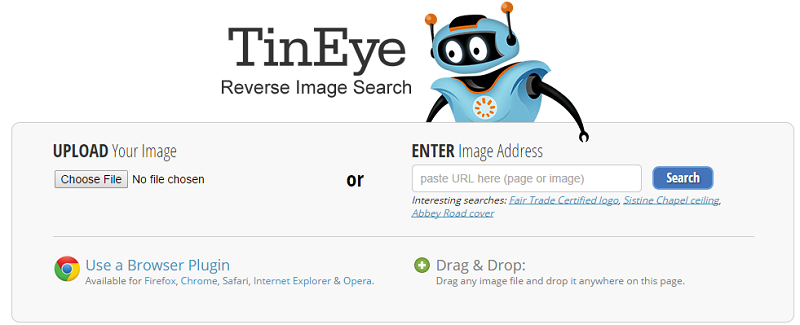
Step 5: Sort by newest links.
Step 5: Check each and every page if they have links pointing to your domain. If a page is not linking to you, find its email address and reach out to the site owner or blogger. You can use the email template below:
Hi [Name],
I’m [Your Name], the [Positon] of [Company Name]. I’d like to thank you for your including our image in your latest article about [topic]. Much appreciated.
Is there any chance you can mention our brand as the source of the image and link to our website? Please let me know if that is possible.
Thank you again. Hoping to hear feedback from you.
[Your Name]
25. Use list post for content distribution efforts
Brian Dean shared a very simple guest blogging process on Backlinko that will get you results for your SEO campaign.
It’s all about using expanded list posts for guest blogging. Just like a simple list, you curate things, tools, resources or tips that are useful for your readers. But in every item on the list, you include detailed sections or put a step by step guide on how to actually do it. This makes it easy for people to extract information or understand clearly each item on your list.
This image below is a screenshot of my old guest post on Search Engine Journal. It is a good example of an expanded list post.
It currently ranks for the phrase link building tips and white hat link building.
Conclusion
Creating content is only half the battle. You’ve got to figure out how you can win in the competition by executing any of the above content promotion strategies.
If you have a content promotion strategy in mind, let me know in the comment section below this post.
If you liked this post, you can subscribe to this blog or follow me on Twitter and Google+.
12 Link Search Tactics to Prospect Thousands of Link Opportunities
Link search is a phase in a brand’s link building campaign wherein most of the building efforts will highly depend on. This is where the success factors of link acquisition are noted, including:
- Obtainability of links, considering the types of links being built (contextual/site-wide, local/international, homepage/deep link, etc..)
- Standard or quality of content existed in various blogs/sites
When done right, link search will provide you thousands of link opportunities that your competitors may haven’t search for.
Below is a list of 12 link search tactics that you can use to create a giant spreadsheet of link prospects that you can later on reach out for link acquisition.
1. Advanced search query
There are many advanced search queries that you can use to prospect link opportunities based on the link building model you’re working on, but there’s only a handful of them that can help you find high quality link targets.
Thanks to Garett Brown that he took time to create this link search query builder. It is a very useful tool to semi-automate link prospecting targeting very niche-specific pages/sites, which are yielded from the keywords, search type, TLD and link type used in searching.
This is the most basic link search tactic that every new link builders must know. If you’re going advance, then you can read the following resources for more knowledge about link prospecting.
Useful Resources:
- Advanced Search Operators Guide: Tips for Searching the Web from SEO Experts
- 21 Link Builders Share Advanced Link Building Queries
2. Topical blogs
If most of your efforts revolve around building relationships with bloggers, then finding topical blogs is the best link search method for you.
Simply do a Google search (“industry” blog) for niches that are not directly connected to your brand but have a community of bloggers who might be interested to link to your page(s).
For instance, this link building blog is focused more on content marketing and link building topics than other internet marketing themes. But even though, I got high quality links from related sub-niches such as CRO, blogging, web design, affiliate marketing and student blogs.
If I would want to expand my link territory, then I can use the following search terms when prospecting for link opportunities, knowing that other niches might find my posts useful for them and probably link to my blog from their own content:
- “CRO” OR “conversion rate optimization” intitle:blog
- “Web design” intitle:blog OR “blog”
- “affiliate marketing” intitle:blog OR “blog”
In this link search method, you have to find the relevancy point between these niches and your brand, i.e. when you do outreach, you must be confident that they’re going to respond to your pitch because they are interested to what you offer.
3. List of lists
List posts are everywhere. And creating a list of these lists will give you hundreds of blogs that you can take advantage of for link building.
Searching for these list posts is easy. You can use the following search queries:
- Top 10 “industry”
- Top 50 “industry”
- Best of “industry”
- Ultimate list “industry”
If there are no list posts in your industry, then create one for your blog. You will have both a list of blogs/bloggers (that are potential linkers) and an added-value content that you can use for your pitch (telling bloggers that they’re one of your followers, as such, you included them in your latest content).
4. Brand partners
Putting brand partners in a list of link targets, for some marketers, would only be applicable for big companies who already had an opportunity to engage with other local and niche brands in the past. Since they had a database of existing partners, there’s a high chance to involve them into the company’s link development campaign.
However, for small to medium sized enterprises, there are still partners that they might consider for link acquisition such as the following groups of people:
- Suppliers / manufacturers who are connected to the brand.
- Local non-profit organizations where the brand had engaged in the past (i.e. sponsorships).
- Local educational institutions with specific courses directly aligned to the company.
- PR companies or news reporters who had just covered the brand for some good stories.
These groups of people can become your list of brand partners, wherein you can easily earn their trusts because of pre-existing relationships with these institutions.
For an ecommerce client, you won’t go anywhere else finding those brand partners. Just look at their website, find a page that says, “List of suppliers/manufacturers”. Start prospecting from there and add all potential link targets to your spreadsheet. However, if there are no existing pages like the example earlier, then simply do a Google search to find you brand partners.
5. Market-centered keywords
One of the key ways to collect profitable link prospects in your database is to understand your market and what your target audience is really looking for online.
For instance, if you’re working for a travel agency, you might consider industry phrases that’ll identify your market needs, such as:
- Travel list
- Travel guide in 2015
- Travel guide in [city/location]
- Best places to see in [location]
- Travel blog with pictures
As you can see, these are the exact phrases people are searching for online to find relevant resources or content about travel, “why” and “what” type of search terms (what is travel) is insignificant to the market needs since people are more likely interested with how’s (map of going to specific location) and when’s (dates/times of best attraction in the city).
6. Search dependent on content contributors
Showcasing your brand’s expertise through blogging (i.e. regular contribution on other related blogs) can drive traffic and referral visitors to your website. When using this approach, the common way to find prospects for guest blogs is adding the terms (“write for us” or “guest post”) to search query, “industry”.
Though you can already find a handful of blogs using that link search method, it won’t guarantee that those blogs are high quality and could provide value to your site (referral visitors and potential conversions).
One profitable approach to prospect for content contribution blogs is finding the best author/blogger in the industry or determining the most active content manager/marketer of your competitor.
Adding the name to the following search queries will end up having a bunch of blogs where the author had contributed his content to:
- “[Name] is a content contributor for [Competitor Domain].com”
- “[Name] is the author of”
- “[Name] is the blogger at”
- “[Name] is the owner of”
- [Name] “author” OR “blogger” OR “marketer”
So if you’re targeting 50 high quality niche-specific blogs, then using that link search approach above could easily help you achieve your goal.
7. Footprint prospecting
Finding footprints of your competitors can quickly help you search for low hanging fruits in link building. However, to some extent, if it is done in a regular basis and this is the only approach you’re executing, then you shouldn’t expect a higher competitive advantage over your competitors (since obviously, you’re just following what others had been doing in the past).
If you’re still building your brand from scratch, you can use footprint prospecting to find bloggers that you can connect with through blog commenting. This traditional link building technique still works when used as a pre-engagement activity before actually pitching bloggers for link requests or other content-led outreach methods.
A quick search query ([keyword] “leave a*” “comment”) could yield a good list of blogs where you can regularly check new posts and add useful and relevant insights in the comment section (to get into the radars of your target influencers).
You may also want to seek footprints of your competitors to find new link opportunities for your brand. Do Google searches for the following search strings:
- [competitor] “interview”
- [competitor] “news”
- [competitor] “press”
- [competitor] “author”
Then click “Search Tools” – Anytime – Past Month.
Here are a few things you can see in the search results:
- Author updates in the blog posts (i.e. editing texts and/or adding internal or external links to improve the page’s ranking potential).
- Text-based and video interviews.
- Webinars, podcasts and press releases of the brand associated by the author/owner.
- Social profiles of the author or the company.
Don’t just follow the brand and its existing authors/owners. You may also want to track the following brand elements and eventually track their future mentions in other blogs/sites.
- Future staff members
- Brand partnerships with relevant brands (supplier to manufacturer relationship)
- Books names or other content assets published by the brand (i.e. whitepaper “author” OR “whitepaper” author).
- Prominent interviewer always pop up in the search results when the search string (“competitor” OR “author” is used).
This link search method requires constant changes in search strings as it would need to adapt to updates happening in competitors’ brands and its industry.
8. Customer Defining Keywords
Customers when finding products or services in search are commonly using terms/phrases that define a target audience or their colleagues (fellow members) in the industry.
So gearing your link search towards what customers are defining their group members will help you discover highly qualified prospects instantly.
For example, if you own a running blog, you can use audience terms like:
- Runner
- Marathoner
- Sprinter
- Jogger
- Trackman
You can add more customer-defined keywords to your list by going to Thesaurus and searching for available synonyms.
You can also try visiting glossary pages in your niche and looking for specific terms that define groups of audience.
Instead of using the head industry keyword to prospect for link opportunities, you can use those customer-defining keywords to build a large database of link targets. In our given example, you can have the following search strings:
- Marathoner “blog”
- Marathoner “resources”
- Marathoner “guide”
- Marathoner “links”
Changing the given customer-defined keyword to other industry audience groups (sprinter, trackman, jogger, etc..) will give you another hundreds of opportunities that you can’t find by simply using the head term (running) in link prospecting.
9. Industry Thought Leaders
This is pretty much the same with footprint prospecting wherein you use names of authors from your competitors’ brands and add them to your advanced search operators to prospect for pages/sites where those authors had been mentioned.
Industry thought leaders do not only represent companies they’re working for but media outlets, content sites, branded pages and communities where thought leaders participated and are credited for their works (by linking to their brands using names as anchor texts).
Take note of brands with attached multiple authors and personalities since partnering with them can help amplify your content assets to a larger audience list (considering the number of followers each of the author has).
Consider Moz for example. The brand doesn’t just have one thought leader (Rand Fishkin) but three or more authors that are active in the community but represents one same company (Cyrus Shepard, Dr. Pete, Jen Lopez, etc..).
In this case, learning from what the thought leaders are working to build their own personal brands will best help your campaign to identify opportunities that will give good impressions for your company as well.
You may also try to determine what topics each industry leader is focusing on. Then try to invest in certain themes (one content theme at a time), then reach out to certain thought leaders who might be interested to consume and share your content.
With Moz, authors have their own themes when creating content:
- Rand Fishkin – videos, webinars and podcasts on advanced SEO and marketing topics (e.g. Whiteboard Friday).
- Pete – data-based content with graphs/illustrations (e.g. Google Answer Boxes)
- Cyrus Shepard – ultimate guides and curated content on advanced SEO topics (e.g. Advanced SEO Concepts)
Pro tip: Adding expertise phrases of authors to search strings (e.g. “guide” “Cyrus Shepard”) would give you pages/sites where content assets of authors had been mentioned.
10. Product/Category Keywords
One of the under-utilized approaches in searching for link targets is adding brand’s categories to search strings. This method will uncover hundreds of opportunities target each and every type of product your brand is able to sell.
Start by talking to your client on what types of products they are selling or simply go their website and look for brand categories.
In our earlier example, you can have these types of products:
- Flat feet running shoes
- High-arched feet running shoes
- Neutral running shoes
- Normal running shoes
Add your favorite keywords (reviews, forum, blogs) to categories (example above) to find loads of pages/websites that can potentially link to your content.
11. Local-specific Keywords
Making your search strings tailored to a local audience helps you discover and participate with local press outlets that have high chances of driving local traffic, resulting in an increase in sales.
Combine your favorite keywords (reviews, resources, blogs) and local areas (e.g. Brisbane) to find local pages or sites. You can also be specific with cities by adding region or state, as well as Zip Codes to prospect for easy link opportunities.
12. Resource Page Terms
Seeking for link opportunities especially resources/links pages requires creativity in brainstorming for new search strings. This is true for industries that don’t have many pages for resources.
In this case, you need to understand what industry terms webmasters are using or targeting in their existing links/resource pages.
In running niche, you can be as specific as possible when doing link search (to find resource pages).
Here is an example of using very specific search terms for resource pages:
- intitle:resources OR inurl:resources “trail running”
- intitle:resources OR inurl:resources “kids running”
- intitle:resources OR inurl:resources “mountain running”
The more specific your search is, the easier for you to filter out irrelevant pages in search results and only qualify those sites that are high quality.
Pro tip: Always check out related verticals as you go looking for link prospects. This might uncover opportunities that could otherwise be undiscovered. In our example, adding these keywords “fitness resources” or “personal training” resources will help you build a large database of link targets.
Other Useful Resources:
If you’re looking for a high quality link building service, then you can contact our team to help you create a link strategy that fits your brand and industry.

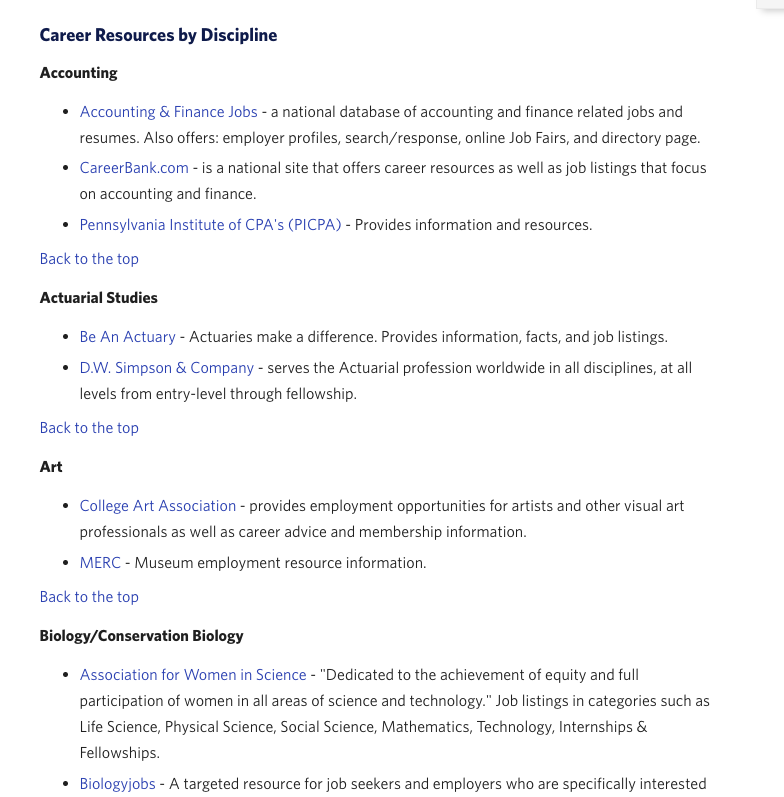








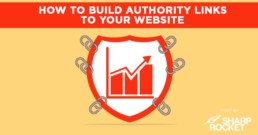

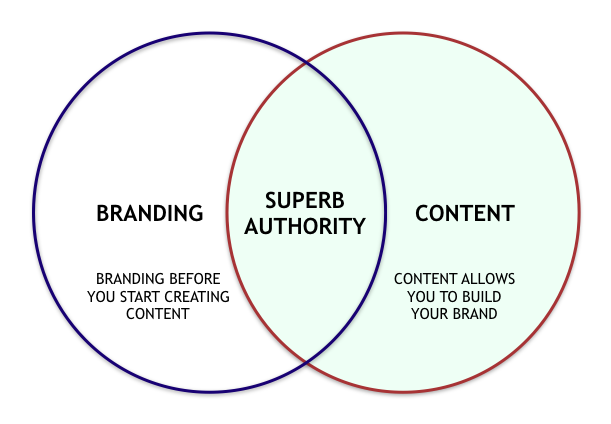
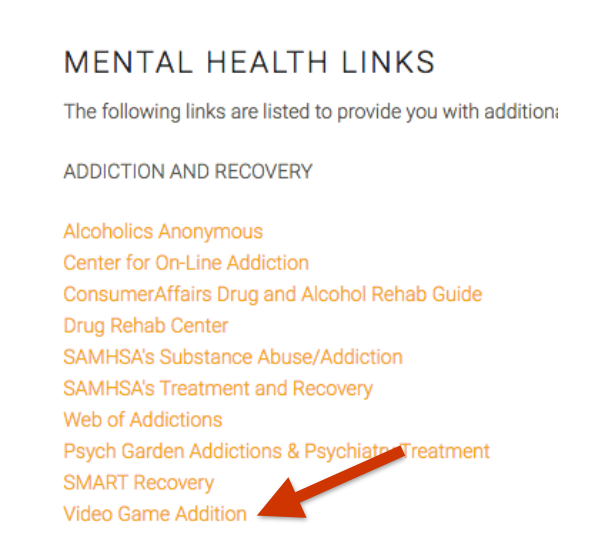 B. Reverse engineer new content assets with highest link growth
B. Reverse engineer new content assets with highest link growth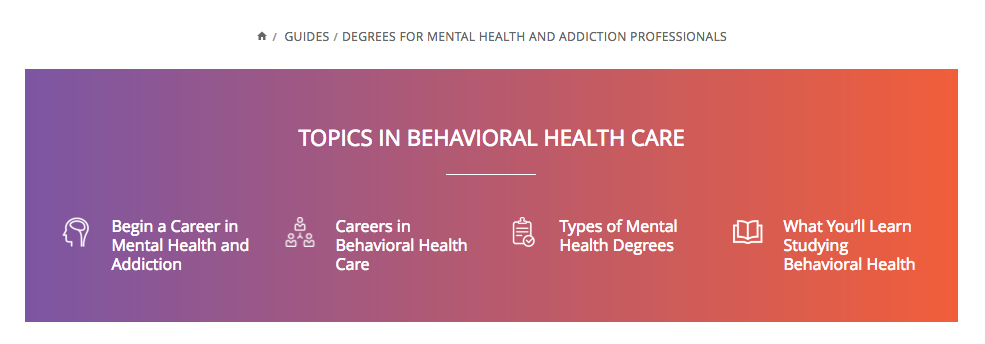 4.
4. 

